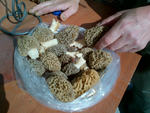Entries in ingredients (72)
Highlights - Early Summer 2012
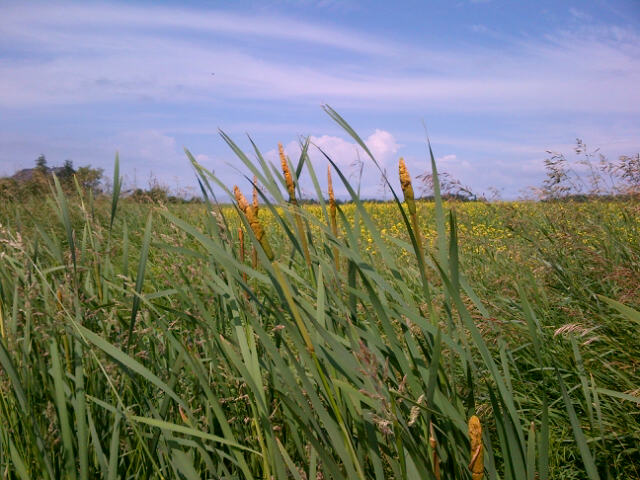 quenouilles (cattails)
quenouilles (cattails)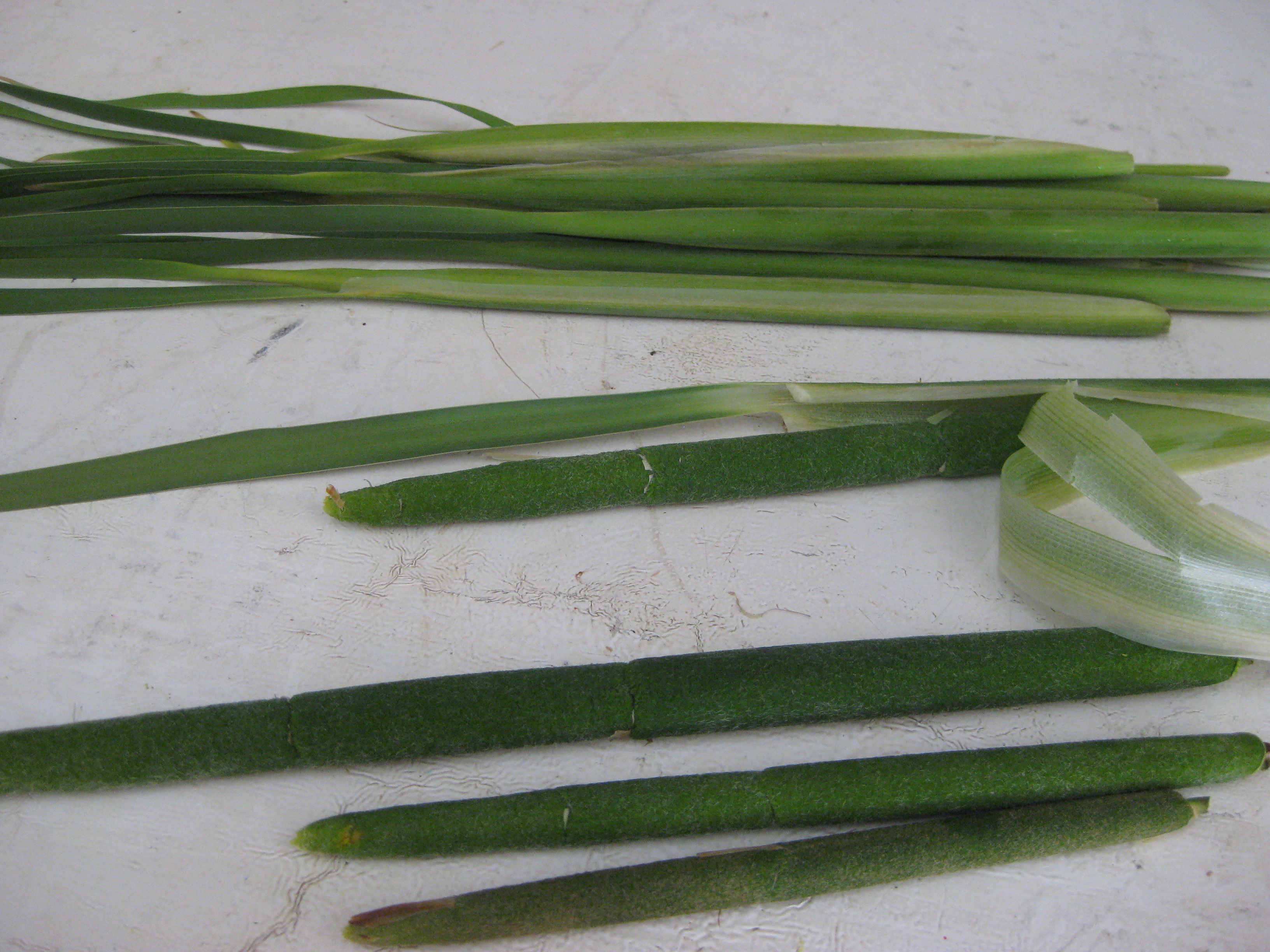 epis de quenouille (cattail spears) - raw and peeled
epis de quenouille (cattail spears) - raw and peeled
 farine de quenouille-pollen (cattail pollen flower)
farine de quenouille-pollen (cattail pollen flower)
True to our annual summer routine at Les Jardins Sauvage, life is all about trying to keep up with the wild plants as they successively come into season whenever they damn well feel like it.
This year is not so different; many July edibles showed up early making for somewhat of a pile-up in putting up/production, but an extraordinary abundance and variety for those dining at the restaurant or frequenting our market stall.
Once the spring things were out of the way, it was all about pickling the daisy buds and soonafter the day lily buds, then it was cattail time.
Or 'Operation Quenouille' as we call it - For a couple of weeks every year, we are entirely consumed with cattails. There is an unpredictable short window to pick the baby spears you see.. We peel thousands, blanch and sous vide them for the year. Everyone on staff is peeling day in day out, every spare moment. Then it's the pollen, which is dried and ground after harvesting. That is hard picking work given this corresponds with peak mosquito season - those responsible are all glad it only lasts a couple of days. In the kitchen, a fine yellow dust covers everything no matter how carefully we work. Blow your nose at home at the end of the day - yellow! Well worth it though; the spears provide a fun local vegetable that you eat like corncob or pogo, and it tastes like corn, with a touch of mushroom and asparagus. Makes a great umami rich vegetarian broth too. We use the pollen in crepe batter mostly, but it can season and thicken stuffings, go into quick breads and cheese. I like to dust savoury fritters with it.
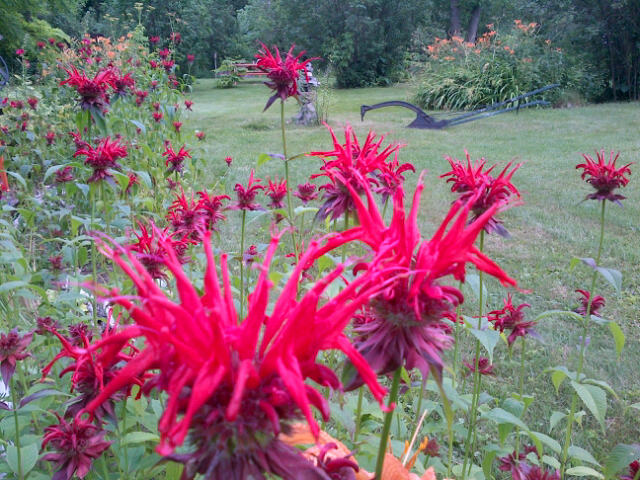 Monarde (Bee balm)
Monarde (Bee balm)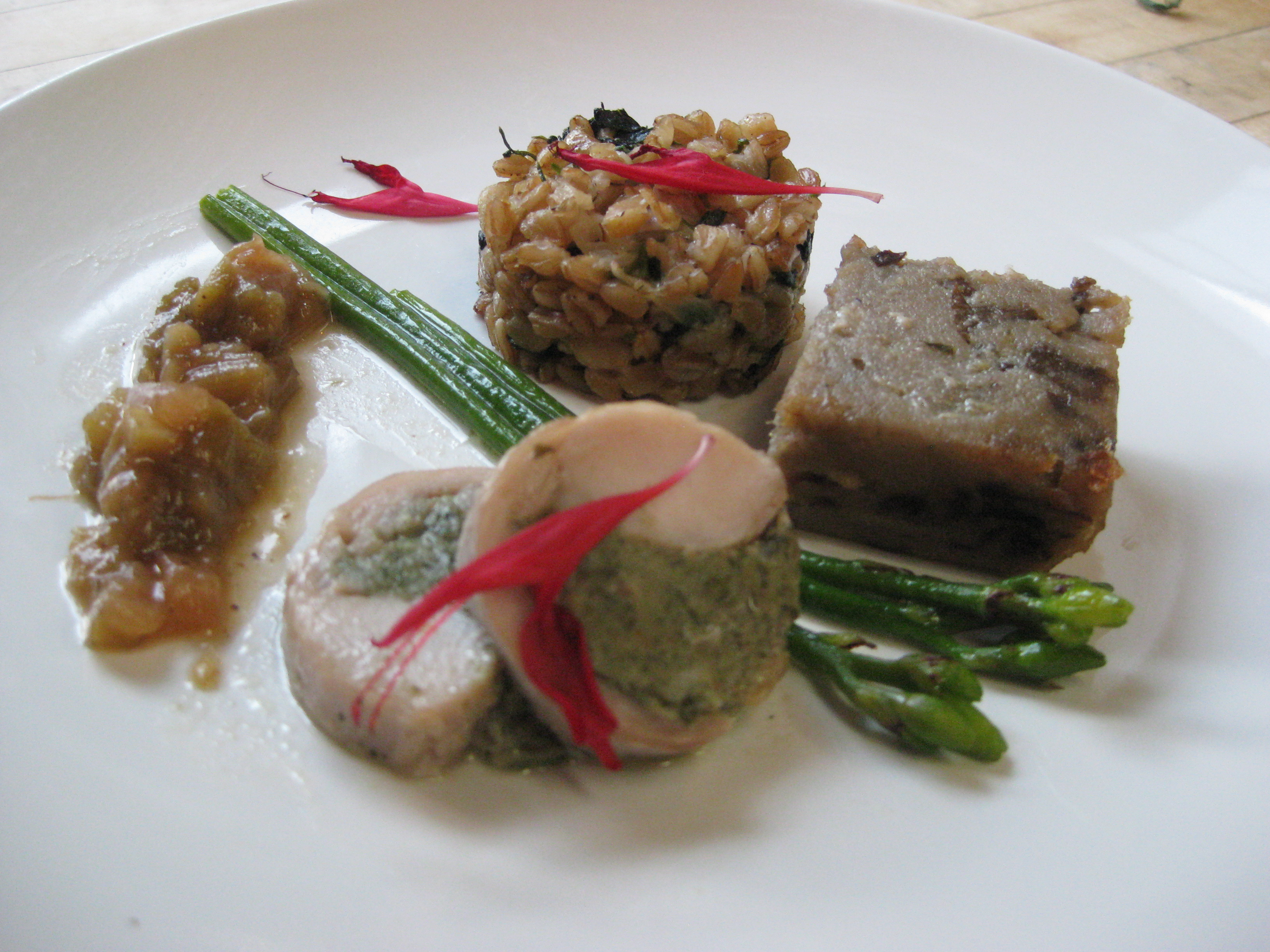 Duo de lapin, ortie & monarde, épautre, pousses d'hémérocalles Bee balm is a favourite of ours. So pretty and punchy, it is more than a colourful garnish; with its thyme like mentholy flavor, it is used more like an herb. To flavour or garnish soups, salads, butter, cheese, sauces, meatballs.. We also dry it and use it in our tisane.
Duo de lapin, ortie & monarde, épautre, pousses d'hémérocalles Bee balm is a favourite of ours. So pretty and punchy, it is more than a colourful garnish; with its thyme like mentholy flavor, it is used more like an herb. To flavour or garnish soups, salads, butter, cheese, sauces, meatballs.. We also dry it and use it in our tisane.
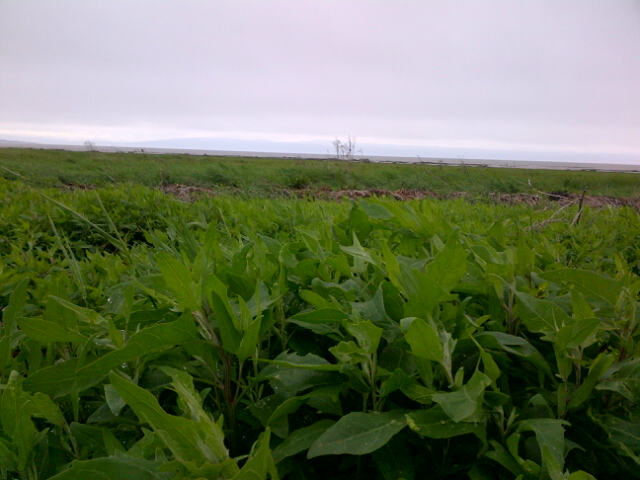 Arroche de mer (Sea spinach)
Arroche de mer (Sea spinach)
Sea spinach is my absolute favourite, like super duper spinach, a notch up from Chou gras (pigweed/lambs quarters), which is also a great, under-appreciated weed. Terrific in salad, even better barely cooked, just wilted with garlic and olive oil or butter. Arroche was definitely a key wild green in our courtship (when I first met François and he was charming me with all his exotic ingredients). We sell and serve up a lot of this fresh in season, but we also blanch and sous-vide a big batch for the year, and we dry some for our salt.
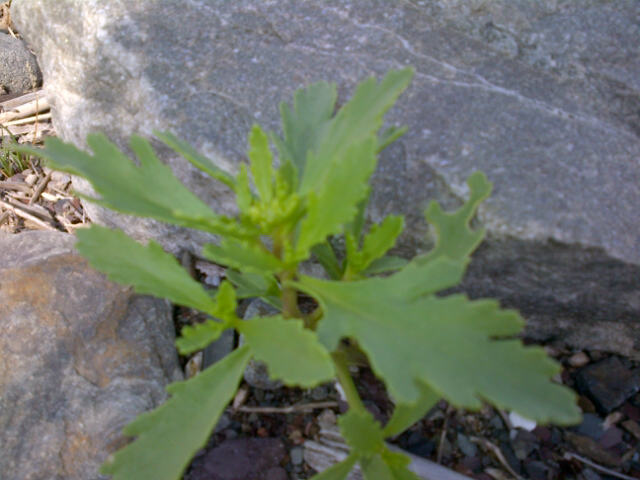 Caquiller de mer (Sea rocket)
Caquiller de mer (Sea rocket)
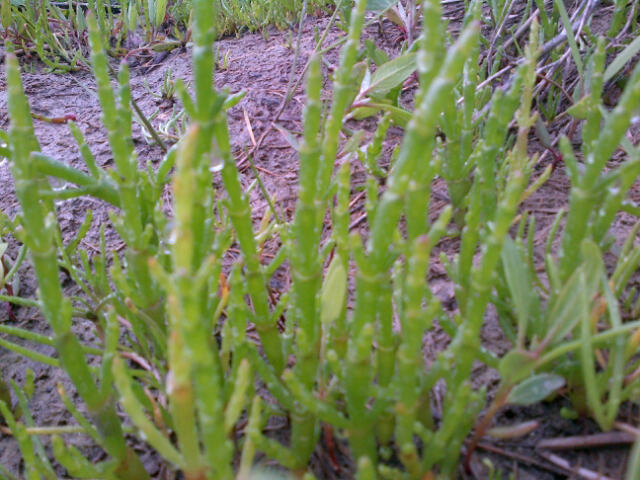 Salicorne (sea asparagus)More sea greens, both very popular at the market. Sea rocket is like sturdy, salty arugula, to be eaten in salad or cooked. Not much needs to be said about sea asparagus which is more widely known, being so lovable, crunchy and salty. Especially ours in peak season, which is picked in the perfect micro-climate, extra special
Salicorne (sea asparagus)More sea greens, both very popular at the market. Sea rocket is like sturdy, salty arugula, to be eaten in salad or cooked. Not much needs to be said about sea asparagus which is more widely known, being so lovable, crunchy and salty. Especially ours in peak season, which is picked in the perfect micro-climate, extra special
.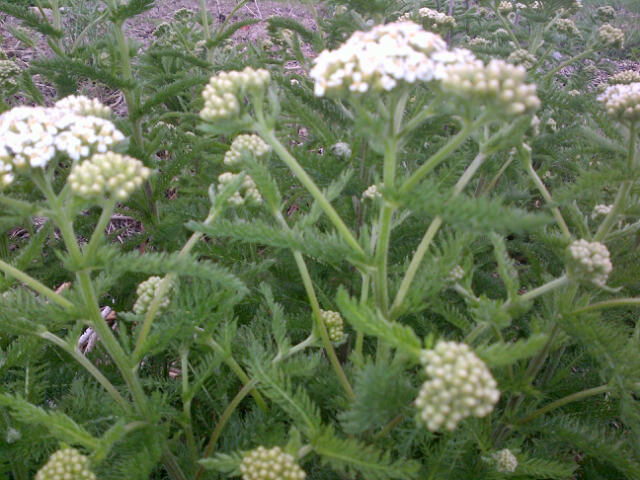 achillee millefeuille (common yarrow)
achillee millefeuille (common yarrow)
Yarrow is everywhere and a mildly interesting herb that we add to our mix. We also dry it for tisane. It is known for all its medicinal qualities (cold, wounds..). The flowers are especially medecinal, so kept for that.
Wild rose petals - one of the most pleasant things to pick, dry or cook! So fragrant and fresh smelling/tasting. We dry a load for our tisane, make syrup and use them in infusions for desserts (juices, coulis, granité). Interesting in savoury preparations too. The fruit, however difficult to work with all its seeds, has a characteristic soft flavour and mouthfeel unlike anything else, ultra high in Vitamin C, somewhere between a tomato and an apricot in taste. Claudie (Jardins de la Mer), our marine green girl, makes a fabulous juice combined with elderflower that is my preferred non-alcholic beverage. Not yet readily available yet outside the Lower St-Lawrence, but something to look forward to.
Spergulaire is another marine green that grows amidst the salicorne and arroche - it is sparse, and hard to find/pick efficiently but it is delicious - tasting like beets, but delicate fresh and crunchy. Sea plantain is kind of blah to me, in that it does not have much character, but mild is fine sometimes too. It is good chopped up in the mesclun or cooked as a side vegetable. The best preparation to me is blanched and served up like green spaghetti sans gluten!
Sea parsley, the marine sister to the wild lovage on our property, tastes like floral, slightly salty celery, and is key in my kitchen. We make a pesto with it, we dry it for our salt, make an infused oil, and it is integral to my chimichurri. I use it everywhere year round.
While all the marine greens are peaking and François is on the road alot, our backyard is orange. Fields of day lily yell out for the taking. Once the sprouts and buds (which are a terrific vegetable) are done, it's petal time. They are best freshly picked and raw in salads or as a garnish, but given the quantity we have readily available, we do a lot more. Of course it takes someone to pick them, but it's impossible to not be sustainable.. I've dried a hundred gallon buckets or so of petals for our tisane and put up half that much in pesto. Delicately floral, even more vegetal-fresh tasting, I make butter with it, as well as use it in preparations to accompany fish, poultry or cheese.
Melilot (sweet clover) is a flower I use more like a spice. It is dried and pulverised to be incorporated into pie dough, cookies.. Most other flowers I prefer to use infused and in the fresh state, but not this one. It is potent and due to coumarine content,should be used carefully.
 églantier (wild rose)
églantier (wild rose) foraging in the worst weather
foraging in the worst weather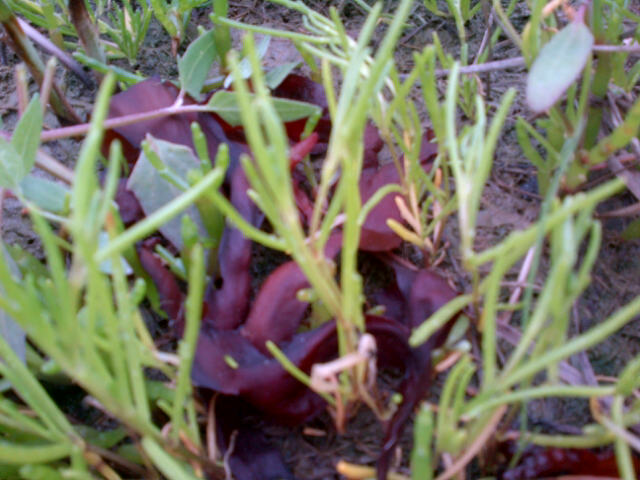 spergulaire (Canadian sandspurry)
spergulaire (Canadian sandspurry)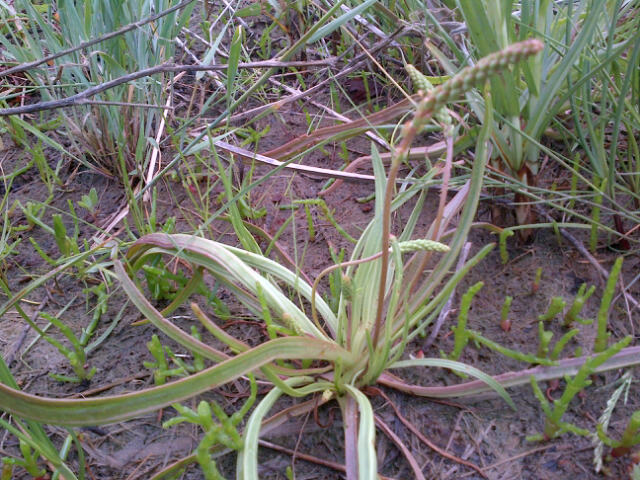 plantain marin (sea plantago)
plantain marin (sea plantago)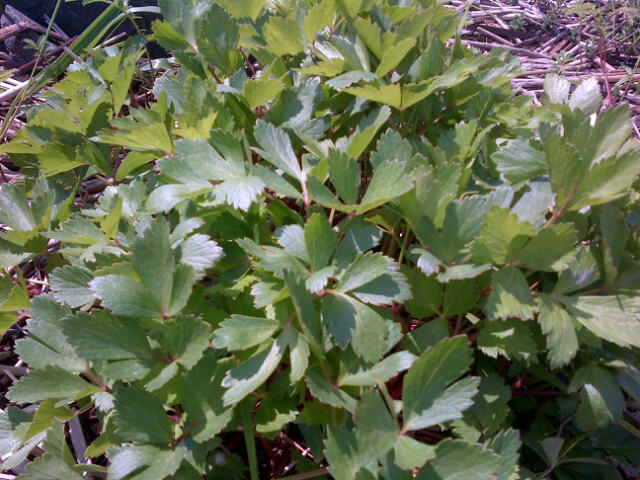 persil de mer (sea parsley)
persil de mer (sea parsley)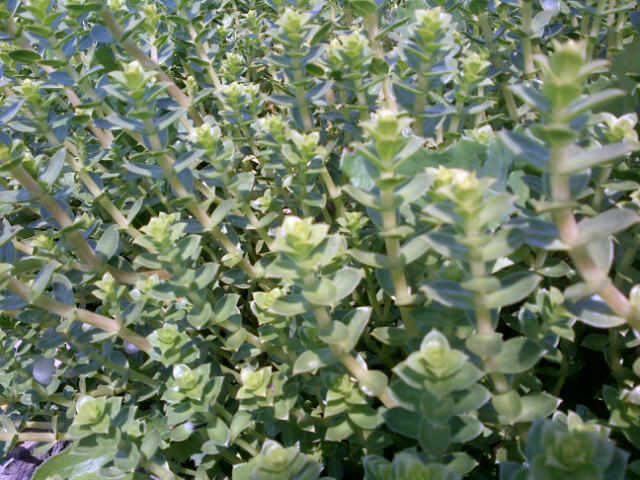 sabline
sabline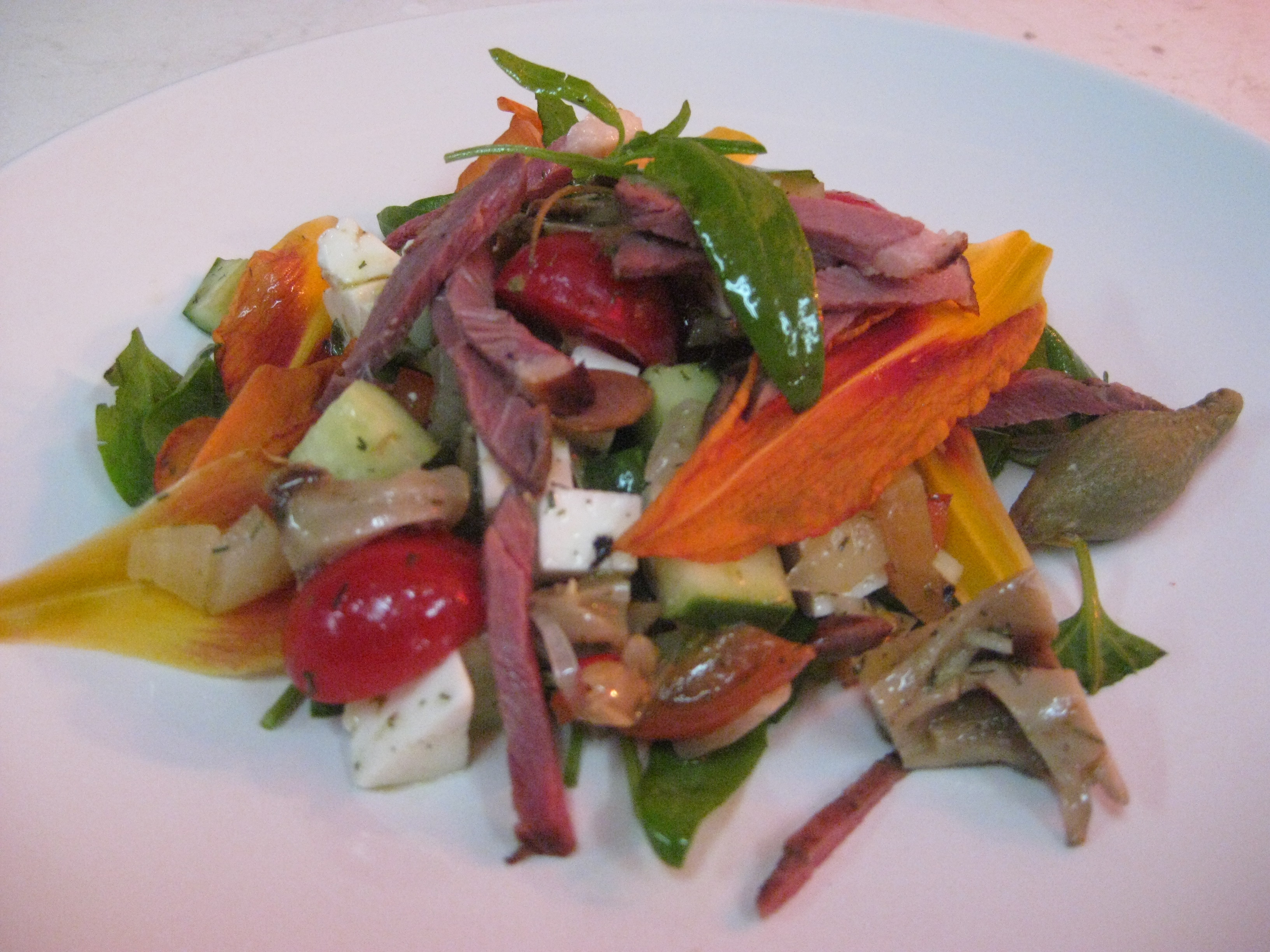 salade d'aroche de mer & hémérocalle, salsa de tomate, concombre et champignons marinés au carcajou, feta de chevre
salade d'aroche de mer & hémérocalle, salsa de tomate, concombre et champignons marinés au carcajou, feta de chevre our field of day lily
our field of day lily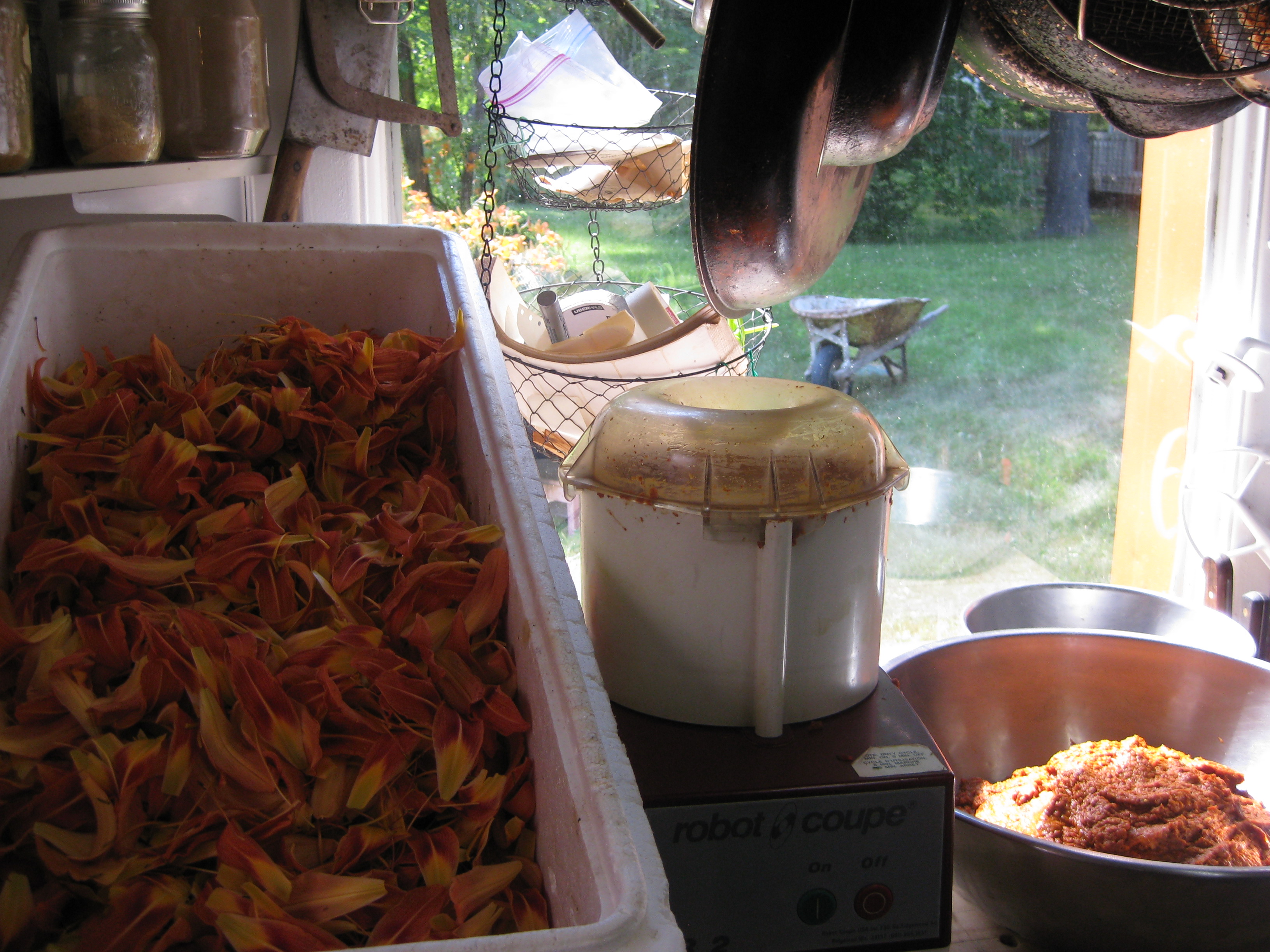 making petal pesto
making petal pesto plantain=green spaghetti
plantain=green spaghetti
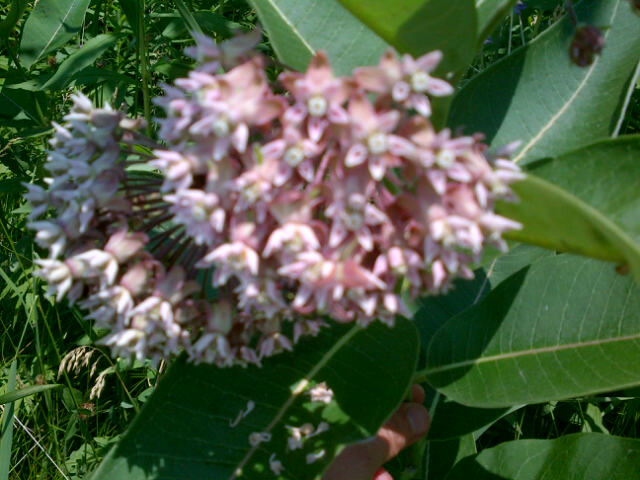 fleurs d'asclépiade (milkweed flower)
fleurs d'asclépiade (milkweed flower)
 brocoli d'asclépiade (milkweed brocoli) - the unopened flower
brocoli d'asclépiade (milkweed brocoli) - the unopened flower marguerite (daisy) - past the point when we use them, but pretty none the less
marguerite (daisy) - past the point when we use them, but pretty none the less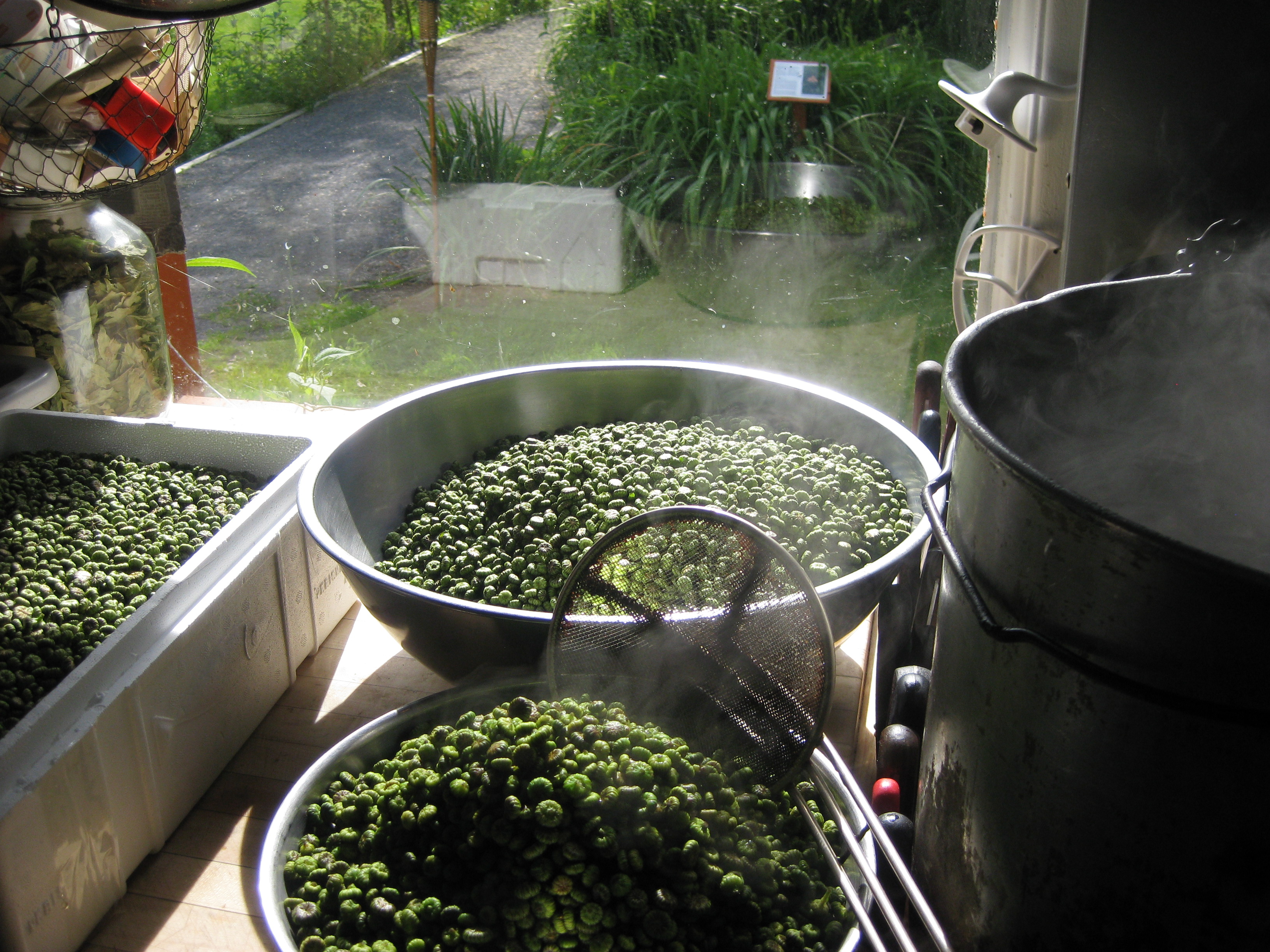 Pickling pounds of daisy buds
Pickling pounds of daisy buds
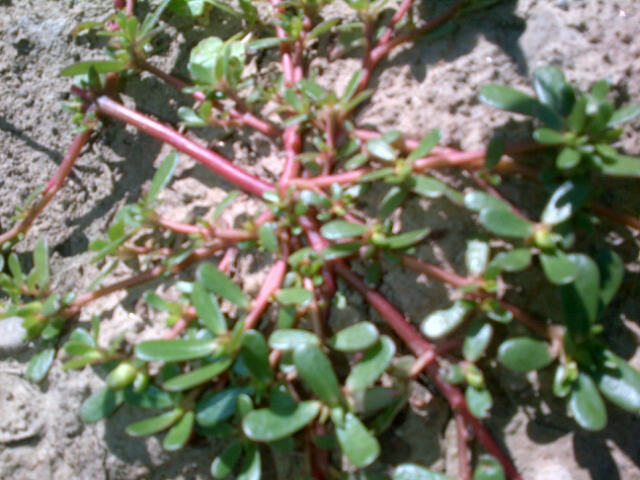 pourpier (purselane) - another hearty weed worth adding to your salad plate - lemony!
pourpier (purselane) - another hearty weed worth adding to your salad plate - lemony! 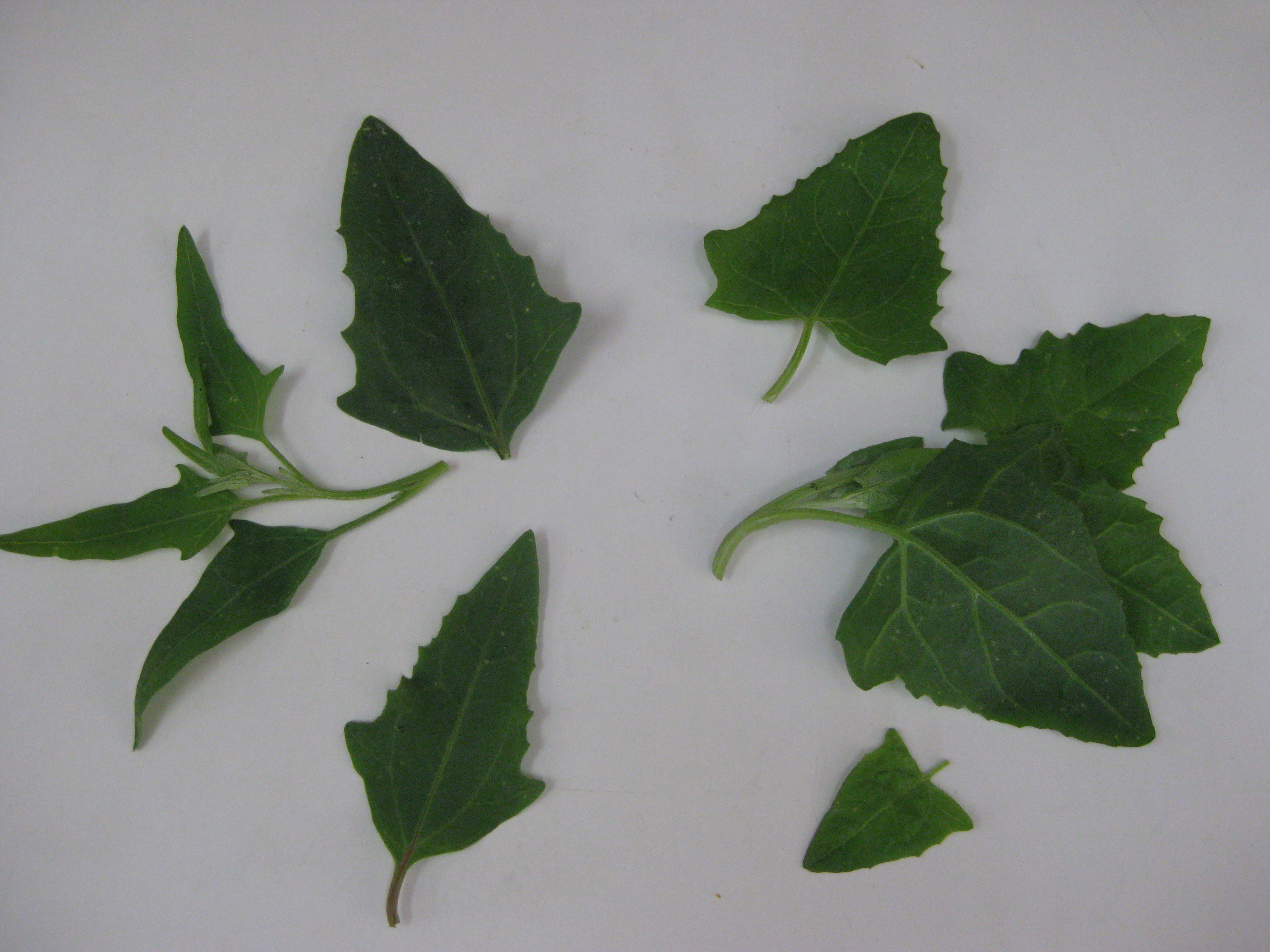 chougras vs arroche de mer (pigweed/lambs quarters vs. sea spinach)
chougras vs arroche de mer (pigweed/lambs quarters vs. sea spinach) 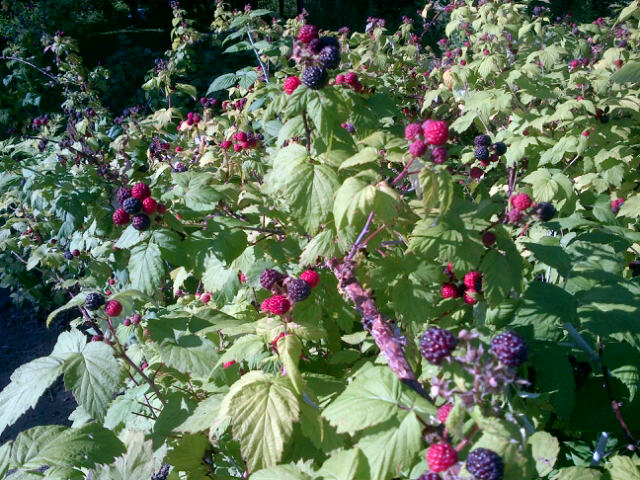 framboises noir (black raspberries)
framboises noir (black raspberries) vesce jargeau (tufted vetch)
vesce jargeau (tufted vetch)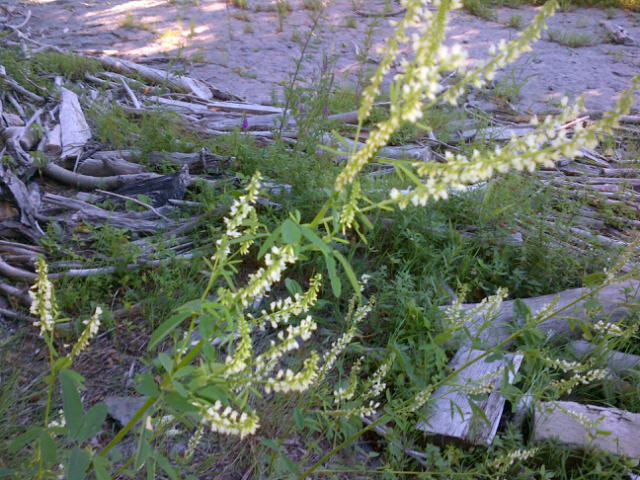 mélilot blanc (sweet clover flower)
mélilot blanc (sweet clover flower)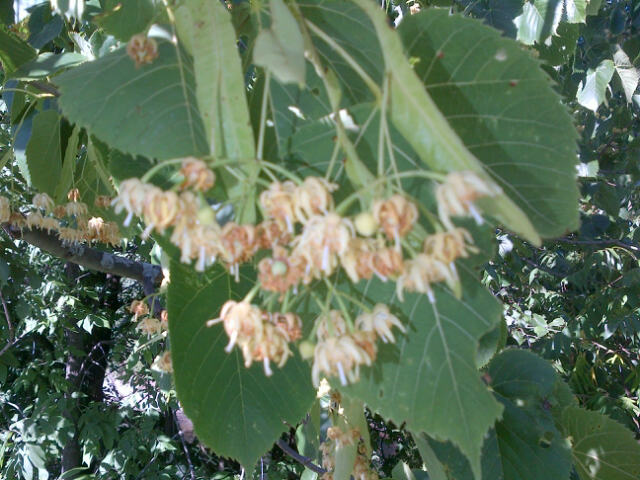 tilleuil (linden flower)
tilleuil (linden flower)
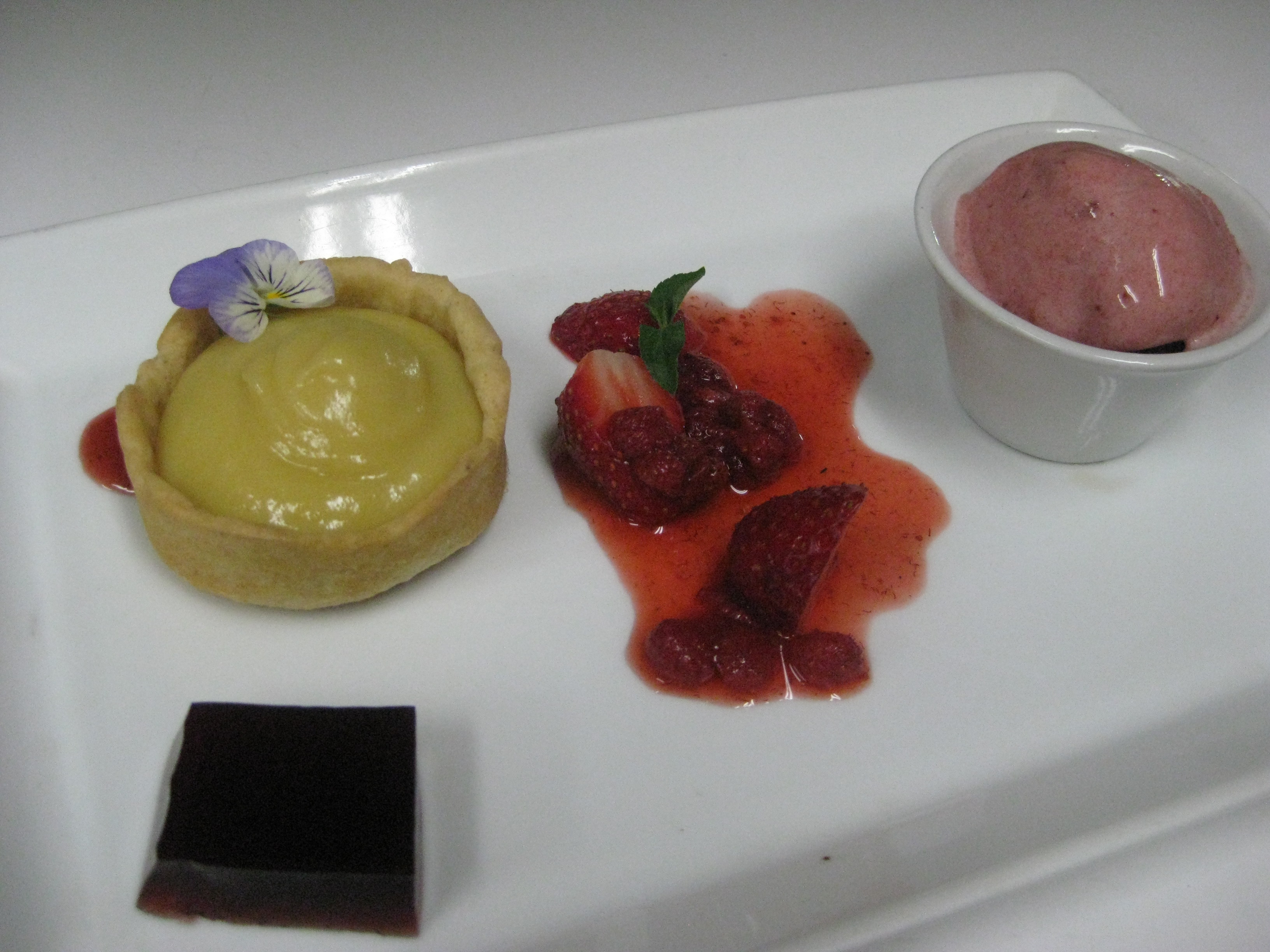 tartelette au fleurs de mélilot et creme de citron-sureau, gelée et sorbet aux fraises aux fleurs d'asclépiade
tartelette au fleurs de mélilot et creme de citron-sureau, gelée et sorbet aux fraises aux fleurs d'asclépiade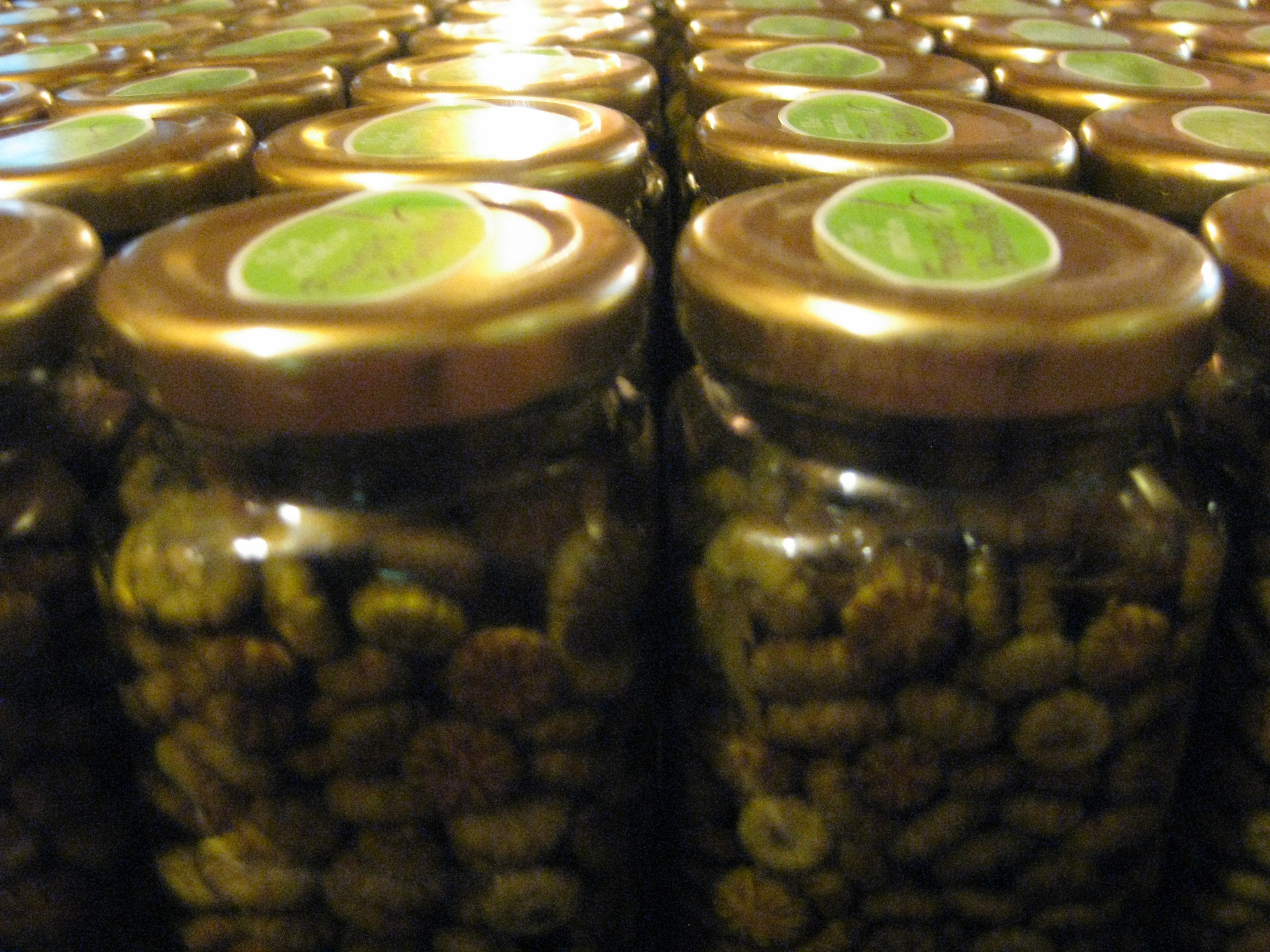 40+ cases of little bud packed jars, ouf
40+ cases of little bud packed jars, ouf
Milkweed flower deserves special mention, because it is so fragrant and particular, quite common and unknown. I love to pair it with wild berries or any fruit - in infusions, so jelly, granité, sorbet etc. What a pretty garnish too! It's hard to believe that they are the next stage in the plant's lifecycle after the milkweed brocoli, which is 100% vegetable. Important to be picked early, well washed and cooked through in lots of water, I typically blanch it for 5min before proceeding with a number of treatments, the most winner being tempura.
Linden is flowering now, and although beyond the leaves in spring, this hasn't been something we've taken the time to exploit; I figure now is the time - the heady accacia like aroma is seductive. Slightly fibrous, I can't imagine using them as is, more likely infused or dried and pulverized..
The sumac ripening shows promise, and our garden of cultivated things is overflowing, which means that the mushrooms are not far off. A few bolets and chanterelles have been spotted, but until this dry weather lets up, there won't be much going on. As we know very well, it can all change in a few days.. Better get as many marine greens in as possible and make sure we have our flowers for the tisane, get going going on the berries. Laitue de mer, check. Because soon enough François will have to let all the rest go and focus on the mushrooms. More madness to follow! 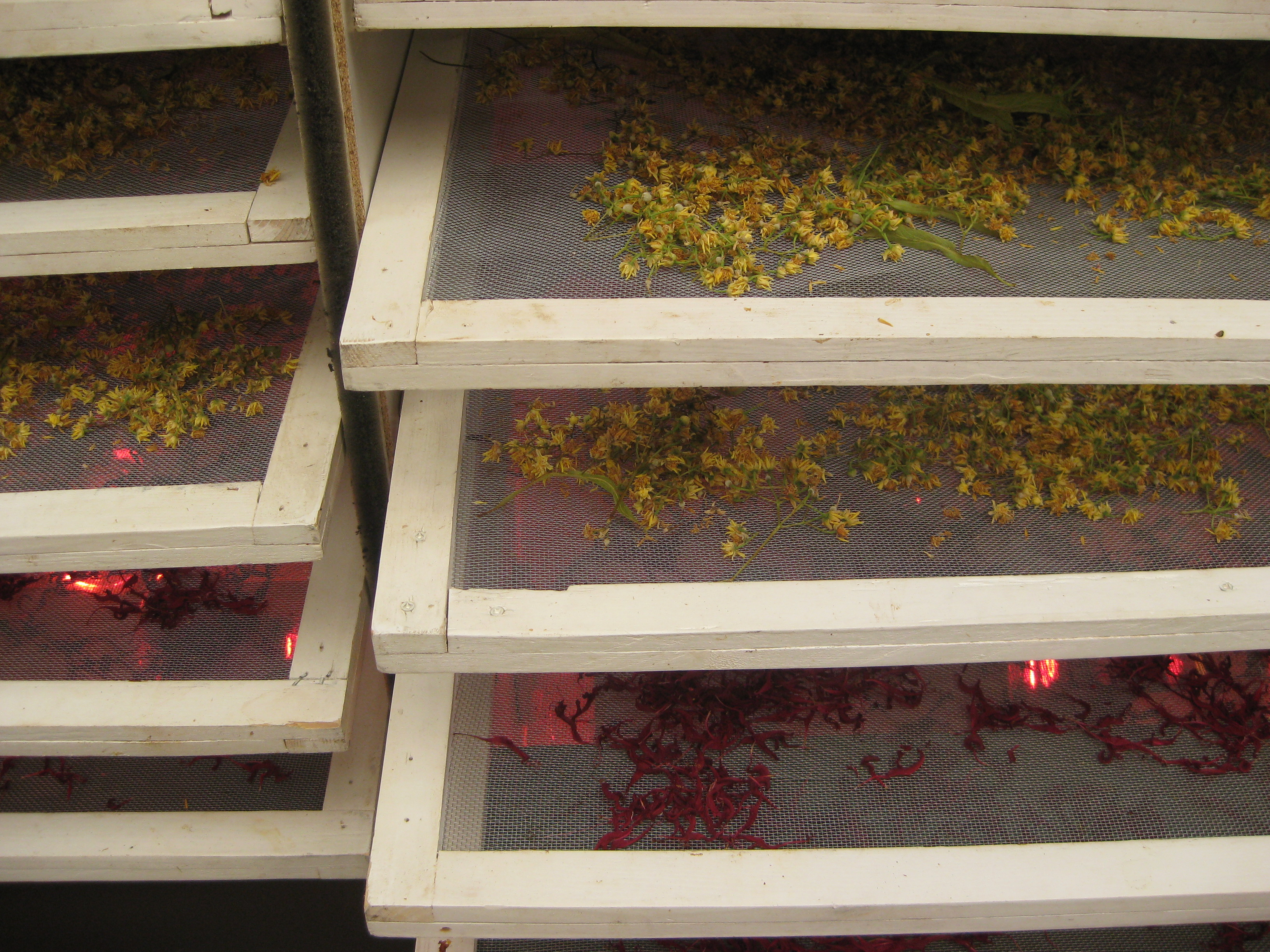 our dehyrdrator is working overtime
our dehyrdrator is working overtime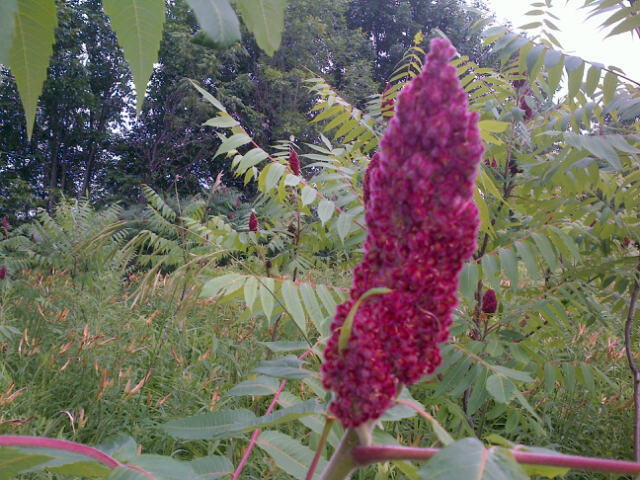 sumac, not quite ready but local lemonade is not far off
sumac, not quite ready but local lemonade is not far off
First morel

First 2012 morel from our backyard! The hunt is on..
Morels are such a tease - one here and there, never a whole bunch (except for up north in forest fire country perhaps).. At least this one is enough to serve two!
And then these showed up, jackpot! Du jamais vu!
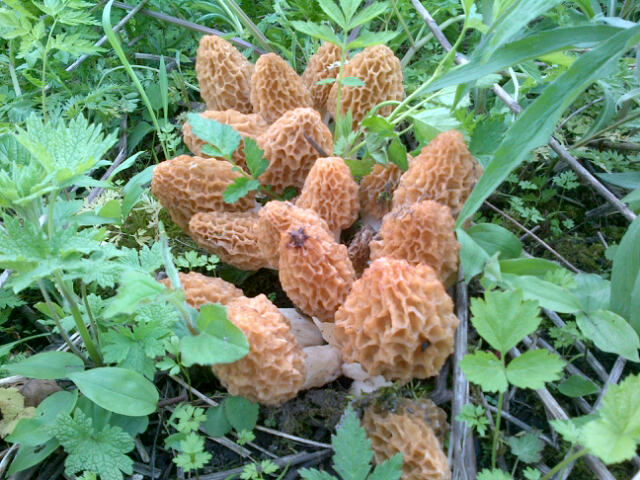 exceptional morel cluster like no one (we know) has ever seen
exceptional morel cluster like no one (we know) has ever seen
Fiddleheads, for once and for all
What to do with fiddleheads for once and for all
As the fiddlehead season peaks, the same old questions resurface.. Clients hungry for the first local greens are keen, but at the same time half frightened, wanting to know how to cook them all over again; the MAPAQ is at our door worried about intoxications..
Although there never has been an incident with our fiddleheads, it appears that every spring in recent years, there have been several cases of ‘food poisoning’ Quebec wide– we’re talking stomach pain here, not death by the way. Probably because a few fools ate a whack of unwashed, raw specimens, perhaps even old and/or from a polluted source, if they were even from the correct fern in the first place..

Sadly, many people are scared of fiddleheads for no good reason. It seems that the government campaign warning about a fiddlehead ‘toxin’ has been effective. In a way, maybe that is a good thing because there are customers who show up at our booth and pop raw fiddleheads into their mouths off the counter, or want to pick their own without a clue, not to mention the growing number of raw-foodists who are determined to eat them raw despite our warnings. Nonetheless, I like to think that most people are not them, and a touch wiser.
The thing is we all agree that uncooked fiddleheads are a bad idea. Toxin or not, there is something in there that makes them hard to digest in the raw state, that animals in the wild are aware of too (they don’t eat them), and besides, they simply do not taste delicious as is or aldente anyway.
It is also important to note that ‘we’ in the New World, have been eating cooked fiddleheads for a long time without a problem – tis a natural, local, traditional rite of spring in Quebec (as well as in New Brunswick, Ontario..). François’ family has been picking in the same sites and eating the same crop that supplies our market stand for over 50 years; François has been harvesting them and selling them for 25 years. And I repeat, never an issue.
After a wave of sore stomachs somewhere in Quebec in the spring of 1999 (60 cases), Govt warnings about a toxin became prevalent. All for a toxin that no one, not even the govt agency seems to be able to identify.
I couldn’t help but wonder about this unidentified ‘toxin’, and how it has eluded us and so many others for decades. Was it really proper to the fiddlehead or in the water? Could the few cases of poisoning have been due to a single source, age or improper storage? I needed to know, but no one has ever been able to answer my questions completely to this day.
A couple of years ago, I went really digging, govt. documents, newspaper articles, scientific journals, to find all sources leading in circles. I even stumbled upon a Santé Canada document that stated there was no toxin in fiddleheads, ha.
Upon consultation with plant scientists at the University of Guelph (the reference wrt food science & agriculture), it seemed likely that the fear might be more bacterial than a toxin persay. Which makes sense given that they grow in dirt and water. And that would explain the govt directives to boil for an extended amount of time; in the case of a ‘toxin’ useless. So, as I suspected, the few cases of intoxication were probably due to a contaminated source eaten raw. But of course, that is too complicated to explain, much easier to issue severe warnings until they figure it out. And without the likes of me pressuring them, I’m not even sure they’re working on figuring it out, preferring to enforce fear and a 15-20 min cooking regimen.
A scientist explained to me how they come up with these numbers in the first place given any threat, ie completely theoretical. They are ultra conservative since they use the most resilient enzyme and the least acid vegetable (not even actual fiddleheads say) for their tests. For eg. at 120C (steam), after 3 min, 10% remains; at 5 min, zero. After 5 min even at 100C, there is not much chance of anything, but to be safe, might as well say 10-15 or why not 20 min, just in case there is the worst ever bacteria in given foodstuff.
Which is fine I suppose; I understand that the government has to protect every person (stupid or not, fragile constitution or not) from every bug and fiddlehead out there (quality or not, fresh or not, from any source, polluted or not). But for us, this is very frustrating on principle; especially that it directly affects our business. After all, this is a super nutritious local vegetable with a long tradition, that is readily accessible and not dangerous at all if fresh and properly cooked. Certainly much safer in the big picture than all the sterile non-food crap coming out of the industrial system that clears all the government lights but is slowly making everyone sick and allergic to nature. Don’t forget that a bowl of berries or a plate of asparagus or a spinach salad might give you a belly ache and send you running to the bathroom if you daily feed off processed food and never eat fruit and vegetables, but then perhaps a cleanse was in order, but I digress.
In particular, we know where our fiddleheads come from, taking care of every detail from A to Z – picking only tightly curled, young specimens barely breaking ground, washing them thoroughly, storing them properly, selling fresh quality, offering up cooking instructions and everything. We have a solid record and reputation. Yet, we still have to defend ourselves year after year.
Meanwhile in supermarkets and via big distributors, there are loads of sketchy fiddleheads being dumped at a low price from un traceable sources, often obviously picked at an advanced stage (easier picking, ie cheaper), and old from being kept too long (from picking time through distribution to package).. I imagine this is the source of any sore stomachs, paired with a handful of mis-informed dopes hitting a bad batch, then not washing them and eating them insufficiently cooked.
Go to any restaurant, or to any home that has had fiddleheads on the menu for generations. No one is boiling them for 15 minutes. They turn to mush in 15 minutes. 5 minutes in boiling water is plenty if you have good fiddleheads and wash them first. Most often, they are given a second cooking anyway, be it pickling or stewing or for a sauté.
I know of one good recipe where they are overcooked and still yummy, from the Bas du Fleuve. Simmered in a salt lard onion broth for 20 minutes, there are left to sit overnight and reheated. Pale green and mushy, they are not aesthetically pleasing this way but delicious, reminiscent of slow cooked collard greens..
However, especially in spring when the body craves it, it is nice to be able to retain some small resemblance of green and crunch along with a thorough cooking. For detailed instructions, see below to see how we tell people to cook fiddleheads..
It all comes down to washing them and boiling in lots of salted water until they are cooked through, period. Depending on the quantity, the size of your pot and water, this could be 5-10 min, even less if the water doesn’t stop boiling. With good fiddleheads properly flushed, your water should be reddish after, not black. I used to stand by a double blanch for less time, but this was with a restaurant setting in mind when you want to optimize color and crunch while ensuring sufficient water flushing and minimal cooking time. But it’s completely unnecessary! It just allows for a touch more texture and colour with equivalent exposure to heat and water. My perfectionism while wanting to cover all bases and please the MAPAQ ended up biting me in the butt because this procedure was propagated and I feel that it ultimately made people even more afraid. I would later hear foodies say, ‘oh don’t you know you need to cook them twice’ and I would inwardly groan; I even heard it from a government official once. Geez, I started it - shut up. I take it all back – just source well, and cook them for a few minutes in lots of water for god’s sake.
They are delicious sautéed with garlic afterwards, with a splash of tamari and lemon, salt and pepper. The oriental treatment with garlic, ginger, chilli, and sesame is winner too. Better yet with bacon, shallots and a touch of cider/sherry vinegar and meat jus. With potatoes and braised meat, in an omelette or with anchovies, pasta and tomato sauce, the options are endless..
The season is in full swing here, about to wind down, but is only getting going in the Outaouais, still weeks away in the Gaspesie.. So there are Quebec fiddleheads to be had for the next month or more for sure..
No need to be afraid. Just don’t be stupid, and Enjoy.
 Here in warm bacon dressing, with wild greens (linden, stonecrop, violet), pickled hen of the woods, crinkleroot eggy potato
Here in warm bacon dressing, with wild greens (linden, stonecrop, violet), pickled hen of the woods, crinkleroot eggy potato
JS Cooking Instructions below..
Cooking Fiddleheads
Wash well and Blanch before adding to a dish: Use lots of salted water, cook for 5 minutes after returning to a boil
*Or Boil twice for less
to optimize colour and texture - Add to boiling, salted water for 2. Change the water. Repeat. Refresh in ice water.
and then sauté
or add to any preparation..
To serve hot :
Sweat with butter or olive oil, salt, pepper, garlic or seasonings of choice (tamari, chili pepper, ginger, citrus zest, bacon, herbs, ie. dill, chives..
To serve cold :
Pickle or Dress with vinaigrette, add to composed salads, pasta or potato salad, greens.
Bon appétit!
*The important thing is that the fiddleheads are of good quality from a traceable source,
that they are washed and fully cooked through.
Les Jardins Sauvages
17 Chemin Martin, St-Roch de l’Achigan
(450)588-5125 www.jardinssauvages.com
Spring is springing
Spring is sprouting, Fiddleheads not far off
 day lily sprouts, terrific gently wilted in butterAfter the false start a couple of weeks ago, it looks like spring is springing right on schedule, if not slightly early still. The day lily sprouts and young dandelion are at their best; the trout lily, spring beauty, garlic mustard leaf just beginning, live-forever breaking ground as well along with the nettles.. There is wild ginger for the picking, the crinkleroot not far off. We have the makings of a spring mesclun – fresh, bright flavours, sweet and peppery, green and crunchy! The first local greens are always so exciting, such a rush, and exactly what the body craves at this time of year.
day lily sprouts, terrific gently wilted in butterAfter the false start a couple of weeks ago, it looks like spring is springing right on schedule, if not slightly early still. The day lily sprouts and young dandelion are at their best; the trout lily, spring beauty, garlic mustard leaf just beginning, live-forever breaking ground as well along with the nettles.. There is wild ginger for the picking, the crinkleroot not far off. We have the makings of a spring mesclun – fresh, bright flavours, sweet and peppery, green and crunchy! The first local greens are always so exciting, such a rush, and exactly what the body craves at this time of year.
 dandelion
dandelion
 ramps
ramps
 Claytonie de Caroline
Claytonie de Caroline
 wild ginger
wild ginger
 tusselage (colt's foot)
tusselage (colt's foot) orpin (live forever/ stonecrop)
orpin (live forever/ stonecrop)
The fiddleheads are about to pop; François has been actively scouting all his patches. At least, the water is less of an obstacle this year; the thaw having come earlier, the rivers are lower. Within a week, we will be swimming in fiddlehead madness, François working around the clock picking, washing, weighing, sorting, coordinating it all. And our Jean Talon stall will be open all week once spring is really rolling. For another week or two, we’re open on the week ends (Fri-Sun).

Hurray! and Ouf, ‘attaché ta tuque’, another season kicks off and our crazy race/dance with nature ensues with all the annual surprises in store..
 first fiddlehead beauties - hard picking since still underground
first fiddlehead beauties - hard picking since still underground
Almost a witch
My path to witchdom via phytotherapy and aromatherapy
Being in the business of serving up wild edibles, there is no doubt that we attract a special sort of clientele – yes, foodies in search of new gastronomic adventures, those embracing the growing trend of local, seasonal, organic and wild, as well as the DIY earth hugging granolas for whom food is medicine and health a religion. The latter always bothered me slightly because I’m more of a hedonist, somewhat of an accidental proponent of healthy food.
Taste has always come first for me. Which has always made me seek out and value quality. The best and freshest naturally means local and seasonal, organic, the least transformed the better. Eco-sense, ethics, community and traceability have increasingly become important to me too. Luckily, wholesomeness follows naturally – bonus!
Up until now, when customers inquired about medicinal properties it kind of got on my nerves.. ‘Just choose to eat good quality, real food, lots of variety, enjoy it! and everything will be fine’ is my mantra. No need to be a strict vegetarian or raw foodist, nor treat food as medicine, follow diets, take supplements or read nutrition labels. I hate the idea of taking the fun out of eating, when it can be such a source of pleasure on a daily basis. Good food and health seem to go hand in hand without too much superfluous worrying. Maybe it’s easy for me to say, because fruit and veg, cheese, nuts, whole grains, rice and moderate amounts of naturally raised meat make me happy - not fast food, big ass feedlot steaks or sweet desserts; wine yes, cola no. It surely helps that I love cooking and have easy access to the best ingredients, not distracted at the stove by screaming fussy kids either.
I stand by this, but now that I’ve got the cooking part pretty much down, I can’t help but be interested in plants as medicine. Just to keep learning, to branch out in parallel, to more fully understand the power of the plants at hand and of our diets and well being in general. And so that my customers don’t get on my nerves.
So I took a few classes at the Jardins Botaniques – on Medicinal Plants, another on Aromatherapy/Essential oils, and oh a perfume atelier just for fun. Wow, another world opened up - utterly fascinating. I remain one who would rather eat my garlic in a dressing or stir-fry rather than oil a clove to be propelled up an orifice (for a cold), but hey, it’s good to know. I now understand the concoctions of smashed greens François slathered onto my bites and burns. I never knew cabbage and parsley leaves could do so much for bobos or nursing mothers, nor how useful clay is. Now I can say that my stinging nettle soup benefits your intestines/liver/digestion and might calm your excited kids right down. I can state with assurance that our house tisane has mega purifying, calming, tonic properties, and pregnant women can drink it in moderation without worries. I’ve learnt about all kinds of new tricks and plants that can heal or at least help most common problems. If I had a baby, I wouldn’t be rushing off to Urgence right away, knowing how to slowly lower the temperature or gauge how serious the trouble is, what to do in the meantime.. I have acquired many more uses for onions, wild greens and many of the things hanging around my kitchen. To think that other budding naturopaths have to go to a health food store and buy powder or pellets.
This is all useful knowledge that will only be reinforced this year as François picks the plants and I cook or put them up; all of a sudden, I will be seeing them in a different light. And I will finally be able to intelligently answer keener granola customer questions with more than anecdotes without wanting to brush them off.
Although less directly connected to our work at Les Jardins Sauvages, I have to say that it is the essential oils that really enthralled me. I am attracted to Aromatherapy because I am a nose person and I love all the natural scents; they just make me happy. Little did I know how much more there was to it though! Being concentrated essences of plants (by distillation), essential oils (not oils persay by the way), they are medicine, natural antibiotics (as well as sedatives, digestive aids, tonics, skin care remedies and everything else..). Of course you have to know how to use them; they have to be administered with knowledge and care because an internal treatment could be like drinking 100 tisanes, an external treatment like putting a ton of petals into your bath or skin cream. (Extra caution is in order when it comes to children and pregnant or nursing mothers). Most commercial shampoos, creams or pharmaceuticals rely on the same active molecules, only from a cheaper source, often synthetic or diluted, pumped up with preservatives and stuff you don’t need, hence the side effects. That’s another thing – I was happy to learn how to distinguish the real thing from all the crap out there. Let’s just say that you cannot trust the chick in the health food store if you’re making your own medicine.
It always annoyed me how unregulated this world was, which made me less inclined to dabble in it or take it seriously. But the great thing about pyhtotherapy/homeopathy and etc in Canada in general is that it’s open – so that if you are well equipped, you are free enough; no need for a prescription or a diploma to buy a plant extract or an essential oil, like in France say. The downside to this is that there is so much fraud & n’importe quoi out there to navigate through, that you can easily hit and miss, give up on a ‘natural’ treatment or even worsen your problem if not well guided.
No, I haven’t started cooking with essential oils – I prefer the plants in their raw state for that. But for the pleasure of a nice scent in the room or on my body; for most minor ailments, colds, aches and pains, skin creams or cosmetics, household products, I’m sold on the merit of essential oils. Even internally for a cleanse or to treat a digestive problem or infection, say urinary or gastro..
For the record, I was never taken by traditional medicine anyway, probably because I don’t like taking pills or foul tasting medicine, but also because I never found that much of it really worked. Luckily, I don’t get sick much, but I’ve become sceptical with respect to doctors who don’t listen and prescribe, prescribe, prescribe. I’d rather deal with my sleep issues than become addicted to pills; I prefer to suffer some pain than feel AFU and sick from pain killers. I dealt with my decapitated nose sans painkillers. Often, over the course of my life, I’ve filled out prescriptions and not taken them, everything turning out fine. I’ve also cooked many fancy dinners for pharmaceutical companies watching them woo the doctors. I’ve lived long enough to believe in the placebo effect, and so if a medication does scarcely better, that’s bogus and not the basis of an industry the way I see it.. Conditions created to justify sketchy products, all the kids on Ritalin - it all makes me queasy. From observing my entourage, I’m also very worried about antibiotics, seeing how often they aren’t effective and what havoc they can wreak on a system. So, if essential oils can do the trick, I’m all for it.
I have yet to personally test a lot of all that I believe to be true, and I’m extremely cautious, starting slowly, reading extensively. Aromatherapy is better documented than you might think. Yet, with what I’ve actually done, I see results and it’s so much more enjoyable than conventional medicine, the aromas! I think François is a little scared. I have a concoction for everything and he is my live-in guinea pig. So as soon as he shows signs of an ache or pain or digestive problem, I’m on top of him. At least he’s getting more massages. He’s right that I was almost disappointed when his cold symptoms didn’t amount to anything one day, all he needed was rest. When he woke up, there were jars of potions waiting for him, not to be tested, sigh.
Here are some simple things that have worked for me (some straight, others diluted in an appropriate oil like almond or noisette, olive or argan) - the tip of the iceberg:
#1 To relax/sleep: True Lavender (also Orange, Ylang Ylang) – on solar plexis, wrists, interior elbows. I’ve been an insomniac all my life – nothing makes me sleep. Melatonin sucks compared to this.
#2 Headache/sluggish morning: Menthe poivrée dabbed precisely on temples, wrists; Epinette noire on back spine (adrenal glands).
#3 Muscle Pain, cramps: Eucalyptus citroné, Basilic, Anis vert, Menthe poivrée, Lavande – massage, works instantly to ease pain/inflammation
#4 Digestion: Basilic, Citron, Menthe Poivrée, Lavande – massaged on stomach. I made this for François but used it one night after a big restaurant meal, felt it all move down, slept well
#5 Psoriasis: Bois de rose, Sauge, Lavande, Tea tree, Menthe verte in Calendula
#6 Mouthwash and spray : Menthe Poivrée, Citron, Thym à thymol, Tea tree, Eucalyptus radié (5% in water, need to shake) – I love this; it keeps your mouth fresh for way longer than normal mouthwash, and a spray bottle in the car makes up for moments when you can’t brush..
#7 Air freshener/sanitizer: Sapin baumier, eucalyptus globulus, lavande, pamplemousse, verveine on and on. I’ve made a few specific deodorizers (bathroom, kitchen) diluted in water and a shot of alcohol. More frequently (every night), I play with the oils I put in the pot on the wood stove like I was cooking up the perfect fragrance for the room & my mood. (I have yet to purchase a diffuseur or nebulisateur).
#8 Kitchen cleaning/cutting board: Citron/pamplemousse
#9 Tea Tree oil: straight onto a new pimple
These are examples of easy external uses, but there are many more possibilities around the household, as well as internally - which I’ve been looking into, with friends and family members in mind. Say for Excema, Flatulences, Constipation, Migraines, Menopause, Sinus issues etc.. Because between FB and me, we don’t have enough bobos to satisfy my hunger to come up with remedies.
Besides formulating my own creams, cough syrup, sanitizer and bugspray, I am very into the theoretical exercise of finding the perfect accessible essential oil treatment for every ailment, also bringing in my plant class and food knowledge, with suggestions for diet, lifestyle and etc, tisanes on the side, and including other old school treatments like the ‘bain de siege’.. So funny, but did you know that sitting your ass down in cold water can do a lot of good things (not just for fever, but circulation, constipation..)
I’d rather eat well and exercise than have to stick a garlic clove up my butt or sleep with crushed onions in my socks and lettuce and/or clay strapped onto my body or sit in icy water, but I guess I’d prefer the above to going to the hospital. With essential oils, I feel like I might be able to keep all that to a minimum when the time comes, no antibiotics or medicine - only rarely some stinky old school witchery.. And as for the pissenlit, ortie, achilée and plantain, bring them on .. All these wild plants seem to be common arsenal – preventative on all levels; ortie our magic plant like ginger for the Chinese. I am now the girl that walks around with a mason jar of some green infusion in hand. I find that it makes me drink more water besides all the other benefits.
Watch out, I may very well be on my way to becoming a witch. However, in my den, there will always be good food and wine and sweet smelling things, not just bitter tisane and painful ointments. At Les Jardins Sauvages, maybe I should make it a tag-line - you get good food, meat and decadence but with a major dose of greens on the side, tisane to finish, phytotherapy!. I could even offer up an essential oil rub or pastille to help digestion for the road, for a supplement of course.
Season finale
The race is over.
There is still a small trickle of hedgehogs and yellowfoots coming in from the Gaspesie (where it didn’t snow), and a few Tricolome up here, but the season is pretty much officially done. We just finished up our annual mushroom event, this year with 30 varieties on the menu! It was a wild success I would say, if not for a few too many last minute cancellations and a touch of staffing stress. All in all, so rewarding though and much fun was had. We’re exhausted.
 late cepe and agaric forestier
late cepe and agaric forestier
Off the menu, the customers loved the 'fromage frais aux morilles', the smoked polypore pickles, both of which we sold a whack on the side. The puffball lasagne was a favourite, and many were turned onto rabbit which was my coup de coeur. But as usual, it was the series of mushroom sweets that wowed the most - panna cotta, candies, cookies, cake and ice cream. It really is surprising what desserty aromas come naturally from mushrooms, especially in the bolete family.


For more photos, here is a slideshow of Mushroom Festival highlights:
A Slideshow.. https://picasaweb.google.com/114806860691793381895/EvenementChampignons2011LesJardinsSauvages
I think we can happily call it a year - and with more than a ton of wild Que mushrooms processed at the restaurant only, that’s enough mushroom for a while thank you. That’s not counting the tons that went to market, only what passed through my hands. A crazy amount of work.
All summer/fall, we wonder what the hell we’re doing amidst the insanity, and every November 1st or so, we pat ourselves on the back and bask in the glory for a few minutes, drink a bunch of mousseux and celebrate a feat accomplished, another year down, with the fresh sweet memories of all the estatic customers..
While it is slowing down at the Jean Talon Market too, we are still there, now only Thurs-Sun. And we remain open on the weekends at La Table for regular business with our equally enticing but more varied 5-7 course menu..
From now on though the winter, apart from Saturdays, we open following the reservations. Which is fine. I have a backlog of orders for products and plats-sousvides, catering gigs, the inventory to do and all other ménage that has been put off, not to mention much less staff from here on in.. Slow down or not, we can’t take it too easy, just a little. François is no longer picking mushrooms - besides some wild mustard greens foraged today, he is mostly busy cutting down trees and chopping wood these days.

But before we get into serious catch-up mode and production for the X-mas markets, we will be taking a day to roast a few pigs on our new spit machine and drink more wine. To close the season, we are hosting a big staff/family party for the market and restaurant team, and all the people who helped us with the house (which is coming along, although still a construction zone, sigh). Mechoui and Oysters and a buffet sans shrooms, Weehoo!.
Apart from that, I’m psyched to be back in my kitchen, cooking up anything and everything, not just mushrooms. Can’t wait to make squash soup, some sausage, experiment with some bread.. Rabbit terrine today.. Soon, it will be tourtiere time!
I love autumn and have my fingers crossed that this isn't the extent of our Indian summer. Dreaming maybe, but I'm ready for winter too. Bring it on, cuz that's when I really play.
2011 Mushroom season follow up
The mushroom season has officially been a GREAT one! Not that it’s over. Many summer varieties came late, some didn’t come at all, and certain autumn ones showed up early. Overall, it has been abundant and all at once - we’re in the thick of things now. The last week of August and all of September has been insane. I’ve been processing 400lb a week. Needless to say, one mushroom or another appears in every dish on my menu. In a couple of weeks, it will be 3 per dish. Some poor mushroom hater came to eat last weekend thinking he was safe, opting to visit before the mushroom event. Not an easy case, but I think I turned him around.
 François arriving with cepe beauties
François arriving with cepe beauties

No records for big puffballs, but we got more than our share of mid-sized marvels- firm, white and pristine. I love giving them an eggplant treatment, frying slices up in batter or baking with herbs and olive oil. Layered in a lasagne or gratin or frittata, they perfume the whole dish. This week, I made a flan with zucchini, eggplant, sea spinach and peppers with a puffball base, all lightly binded with some egg and a dusting of parmesan that pleased. So rustic and very old school, yet beautiful and tasty. It helped that I served it with a slice of rolled lamb belly, brined, smoked and cooked sous vide then crusted, and some yellow-foot and hedgehog mushroom-tomato ketchup.


I have never seen so many Bolets à Pieds Rouges, a variety I love for desserts but worry about running out of. This year, it may very well make it into our mix, bonus. Same with the Bolets à Pieds Glabrescent. It was an awesome run for Porcini too, but the autumn ones are by far the best; in summer, they are rarely worm-free. I’ve never seen so many perfect little firm bouchons, and tall firm ones too with a long meaty tender stem (the best part when young). It is a lucky year when you can eat cepe tartare for a month straight.
 Yes, the red-mouthed boletes turn blue when cut!
Yes, the red-mouthed boletes turn blue when cut!
 local cepes
local cepes
It was a magnificent season for Yellow-foot chanterelles, and I think they are my new ‘coup de coeur’. So delicate, yet flavourful, pretty and delicious fresh or dried. It took me years to ‘get’ this mushroom, and I don’t see why. Initially, I wasn’t taken with the way they went limp, but now I don’t mind that, and they do retain a certain chew. It has always been my go-to to candy, so cute and tasty when raisin like or made crispy, tastes like caramilk. But it is equally dynamite in savoury dishes when you want a little mushroom enhancement without it taking over the dish, say with fish or in a soft salad..
 chanterelles en tubes dans le sechoir
chanterelles en tubes dans le sechoir
Amanites des Césars, trompettes de la mort – both always rare and hard work, but François was rewarded albeit with much time and mileage. These mushrooms are priceless. The first so buttery soft and unique, just gently sautéed; unfortunately there are never enough to go around. The latter is definitely one of François’ favourites (mine too!); he likes to make black omelettes, quite yummy. I prefer them at dinner and like to put them up to stretch out all year – to use in our mix, to make fresh cheese with, to take a potato dish up a notch. I say who needs truffle when you have trompettes – they have a similar complex earthy, musky aroma, but less stinky, more delicious - notes of cheese, artichoke, licorice, caramel, deep and lingering.
 baby amanite des césars
baby amanite des césars
 The prized amanite in diff stages
The prized amanite in diff stages trompettes de la mort
Now, it’s Armillaires and Matsutake, Polypore Hen of the Woods occupying my fridge space and time. More pickling this week! We should have stakes in the mason jar business.
 armillaire et matsutake
armillaire et matsutake polupore poule des bois; hen of the woods
polupore poule des bois; hen of the woods
 pholiote ridé
pholiote ridé agarics forestiers
agarics forestiers
The nasty ones were everywhere - a good season for ALL shrooms!
 toxic!
toxic!
The first signs of autumn beauties are appearing, the last flight.. Bolets jaunes, cepes des meleize, pleurotes d’automne, coprins, lepiotes, tricolomes... Hoping the fall will live up to the summer!
 Lactaire Delicieux - in season now, so fragile!
Lactaire Delicieux - in season now, so fragile!
One more month or so of dirty fingernails, mushroom fumes and dreams..
Spring has finally sprung
Spring has finally sprung! Yay.
Believe it or not, two weeks ago, there were still patches of snow in the woods. Even a couple of days ago while François was scouting his first fiddleheads in swampland, there wasn’t much happening in the forest. But in no time, the telltale whiff of garlic and crinkleroot came wafting above that of fresh dirt as I strolled down the path to the kitchen. That day, I knew François was out there somewhere on his hands and knees if he wasn’t in his bootsuit chasing fiddleheads..
Venturing out back, and then to the neighbouring maple grove, sure enough, there were promising tufts of green everywhere.. Ramp leaves shooting up in gangs, alongside a smattering of baby trout lily, the odd cluster of fiddleheads, and striking (but inedible) trilles. Brushing aside the dead leaves around the ramps, there was lots more to be found – the first crinkleroot, wild ginger, more ramps, ulvulaire, spring beauty and more..
 trout lily
trout lily spring beauty
spring beauty
Right around the table champêtre, the orpin (live forever) is now popping up, the dandelion is in full force, still baby primo and actually edible this year (all the rain?), and there’s the miniature first daisy, my ‘coup de coeur’. Violet, bee balm and garlic mustard are showing signs of life, edible leaves soon, which means the linden, the flowers, and the next slideshow is not so far off. Spring was late, but I bet summer will not be. Even if it snowed in the Laurentians last night.
 ail des bois
ail des bois
 orpin; live forever
orpin; live forever
 dandelion
dandelion
In any case, within days, there will be a true bounty of spring greens, fixings for a meslun that explodes with flavour – providing that jolt of fresh, assertive green vitamin crunch our bodies crave after a long winter. A Green flavour boost that imported Romaine cannot deliver.
For the month of May, this forest is our pantry, and salad has to be on the menu. It is François’ favourite time of year because of the fiddlehead tradition, but also for the abundance of different edibles all growing together. Nothing beats the smell of the woods at this time of year either. It’s not all about mushrooms after all.
Of course, there is the squadron of female pickers who show up in spring, those patient enough to do the meticulous hand work that the sprouts and flowers demand. So different from the hardy gang of rough and tough beer swilling fiddlehead pickers. And trust me, this season, you have to be built strong to be doing fiddleheads, a girl my size would be swept away with the swollen river getting to the sweet spots. François skirts back and forth, the king of fiddleheads and part of the motley crew, but equally adept and at peace with the girls clipping and coddling roots and shoots, in there with his deceptively delicate man hands and feminine sensibility. It is in Spring that I see his most tender side, and his fiercest too, in terms of stamina. Out foraging in the rain, to and fro from the market, washing all those fiddleheads at the end of every long day...
It is busy yes, but smooth splendor for two weeks at least.. Picking in the same few spots. Silence apart from chirping birds. When the foliage comes in, all this dies and we move on. Then other things arrive in season, but dispersed, unpredictable, one thing at a time all over the place, so much prospecting, running around the province... A whole new kind of Hectic. Mushrooms are much more complicated still.
I wish I could seize a spring moment, capture it fully, remember it perfectly all year.. More than a picture or caption or singular thought, but that magical fresh feeling - the energy and excitement inhabiting everyone; the scents, the tastes, and hopes for the season; the invigorating comfort of communing with nature again, seeing and eating green again.
From one squat stance, reaching in all directions, with a few careful handfuls, you have the makings of a tableau or a lunch. With a half dozen plants, you have a combination of contrasting textures, notes of sweet to offset the pleasantly bitter, as well as a spectrum of fruity, floral, green and peppery aromas.. Ultimately a salad that is exciting for the palate, soul and body, loaded with iron, vitamins, minerals protein and antioxidants.. that tastes like spring!
 ulvulaire
ulvulaire
 ox-eye daisy
ox-eye daisy
Trout lily(cantaloupe), live-forever (snow peas), daisy (sweet licorice), Dandelion (bitter), Ulvulaire (walnut), crinkleroot leaves (mustard and horseradish), and tender Spring beauty (finesse)..
All you need is a good cold-pressed oil and some salt for absolute deliciousness. As a side, that’s fine, but these greens can definitely stand up to a punchy vinaigrette too. A touch of sweet to counter the bitter/astringent is often a good idea. I make a wild ‘chimichurri’ that works well, as does a wild berry vinaigrette, or aged balsamic or sherry vinegar based vinaigrette. I like to chop up some ramp leaves and any fresh herbs that are kicking around, especially dill, parsley and chives. Scallions are essential. Nut oil or nuts also make a good addition. Meat, meat drippings and fat all marry well, softening the wild greens, a marriage made in heaven. The smallest hit of umami in the form of bacon, smoked duck or cheese shavings will do the trick, taking healthy green salad to full-on gourmet entrée. Topped with shrimp or grilled meat, you have dinner.
Day lily sprouts can be thrown in too, but I like to treat them as a vegetable on their own– delicately floral and leek like, with a hint of truffle – delicious sliced thin and served raw in a light vinaigrette, or simply wilted in beurre montée. With fish, poultry, mushrooms..
 day lily shoots
day lily shoots
Growing in the same woodland, scattered among the spring greens are two precious roots, easily identified by their leaves at this time of year. Feeling down the stem, a pencil thin root is revealed, linked to a larger network underground, quite extensive depending on the age. We only snap off the first link and sprout, leaving the rest behind, which seems to stimulate the plant if anything. For the record, François does not rip out any plants by the roots. Across the board, we have a healthy supply every year in the same locations François has been tending to for 10-40 years.
First there’s François’ family favourite (and now mine too) - Crinkleroot.. With its hearty bite of mustard-meets-horseradish, it is nutty and peppery, very arugula like; both the greens and the roots are widely used in my kitchen.. In chopped salads, sandwiches, condiments and sauces, with tomatoes, cheese, seafood and steak.
 crinkleroot
crinkleroot
Then there is Wild Ginger- pungent like ginger-root but incredibly aromatic, floral and fresh smelling, exactly like the flavour of soap gum (Thrills), but cleaner, more natural tasting. Sounds gross maybe, an acquired taste not unlike coriander or saffron, but it is amazing to cook with in both savoury and sweet, when keeping it subtle. I use it fresh, I pickle it, I make it into mustard, paste, syrup and sugar – all handy ingredients to add wild ginger zing to preparations in different ways year-round. This week it’s in an Asian inspired vinaigrette for shrimp and fiddlehead salad; next week it will be with chocolate in dessert
 wild ginger
wild ginger
Of course, among the spring things, I cannot not mention fiddleheads more than in passing. A week into the season, we have a thousand pounds in our cooler, with thousands to come in still. We have a ton on the property, but it is a shitload of work. François was one of the first to put these on the market and takes great pride in it. I will be serving them in a myriad of ways fresh for weeks to come. Some will get put up, some pickled, most sold at the market.
I prefer them cooked and served hot with bacon or something meaty, but early season, I am happy to eat them in salads with some crunch. After washing them well, I blanch them for 5 min in lots of water and either reheat to serve warm or toss in vinaigrette.
So many people think fiddleheads are touchy or dangerous. The Cdn and Que governments say you should cook them for 15 minutes or 10-12 by steam due to some unidentified toxin. No one seems to know what this toxin is but affirm that it is water solvent. Yet other govt agencies have tested fiddleheads and not found any inherent toxin even raw. All cases of stomach upsets (very few) came from uncooked fiddleheads from unknown sources. (Probably polluted and improperly washed and cooked). We all agree that they should be cooked (they aren’t good raw anyway). To be safe, just wash well, use lots of water, and cook them through, no straight sauteeing. These guidelines seem excessive, but I suppose they are conservative to protect every idiot, scenario and fiddlehead out there. Personally, I believe 5 minutes in lots of water is sufficient with fresh fiddleheads from a reliable source. In previous years, I decided that with small batches when I wanted to conserve the most green and crunch, blanching twice for less total time optimized color, texture with respect to maximum cooking and water flushing. But now, I don’t bother. I don’t care about ‘aldente green’ like I used to. For flavour, more is better with fiddleheads.. But quand même, not 15 min!
 lugging in the mother load (fiddleheads)
lugging in the mother load (fiddleheads)
Greek Easter soup
My Greek Easter Soup with Lamb Lungs
Every time I get a lamb from Genevieve et Nathalie (L’Agno et le Lapin in St-Julienne), I break it down and use just about everything nose to tail style. The gigots get separated from the rack, the flanks go to belly/ bacon, the shoulder divided into roasting and braising muscles, the offal put aside for terrines or a mixed grill. The tongue and cheeks and heart are so small, barely more than a snack for the cooks. Bones and miscellaneous bits go into the stock. I even keep some of the fat for sausage or petit sale since this young lamb fat is mild tasting even buttery with the babies. Not crazy about the liver, I still manage to make a decent paté that is quite appreciated by lamb and liver lovers. But I never knew what to do with the lungs. So I vacuum packed and froze them. With a set of lungs per lamb, they have accumulated. Then this week, Genevieve gave me a bag of lungs that she had been collecting for a European customer who disappeared. She didn’t know what to do with them either.

Not particularly inspired by this organ, I now had no choice but to get creative and tackle a recipe or two. With the season starting, I need the freezer space and it just seemed wrong to throw fifteen pounds of protein into the trash.
I remember a fellow cook of Greek heritage telling me they made soup with it on Easter. Makes sense since they like to roast a whole lamb on a spit and historically let nothing go to waste, giving them something to snack on in the meantime.
With Easter around the corner, I looked it up – Mageiritsa; I was feeling gung ho. I liked the idea of onions, lemon and dill (always good), but didn’t want eggs in there. A quick internet search told me that there existed all kinds of lung dishes. In India and Pakistan, they made lung curries. There’s the Scottish haggis, Zuppa du Polmore in Italy, German sour lung soup, spicy Asian noodle dishes. In fact, most countries have a traditional lung recipe; apparently it is only in North America that we shun it, like most offal. Undoubtedly because the average family (or restaurant) here is far down on the food chain, numerous degrees of separation from the animal, nor living any real necessity of frugally making the most of every morsel.
When I think lamb, I think spices – cumin, fennel, mustard, red pepper.. Or herbs like thyme and rosemary, tangy condiments like preserved lemon and olives. This brainstorming had me salivating and eager to get started on my own Easter soup - a mix of the various recipes I had seen, a dash of my own style and a lot of what was in my fridge.
I had already put the lungs in a light brine to degorge (standard procedure for many variety meats), giving me a night to figure out what to do with them. I saw that I had to sous-vide the fresh ones first to rid them of the air so that they wouldn’t float. This turned them from a bright pinkish-red to purple. Hmm.


The next day, I threw them into some boiling water and simmered for 15 minutes to blanch and firm them up so that I could work them. Most of the recipes I had seen started this way, and it seemed right given the spongey texture (think sweetbreads or brains or testicles). Slicing the lobes open, I felt like I should remove the tough looking ducts and vessels, at least in large part. Then I cut them up and threw them into a sauté with onions and bacon fat (when in doubt, add bacon!). I added garlic and spices: thyme, bay, a hot pepper, some panch foran and a lemon wedge. I deglazed with some white wine, added some tomato and lamb stock and put it on a very slow simmer. Meanwhile, I put on some basmati rice to cook on the side with a clove, a bay leave, and black pepper, to add later. I had some crunchy Jerusalem artichoke from a sous-vide experiment that I diced up to mix in near the end. Sea parsley pesto kicking around - perfect. I was psyched.
Soon enough, the kitchen smelled heavenly, but the lung pieces didn’t seem to be changing in the cooking process. Maybe my heat was too low; I wanted them to become tender, but was fearing they would turn to shoe leather. After an hour, even two, I wasn’t thrilled with the texture or the taste of the lung, although the broth was incredible. I reasoned that I should be patient. There was no way I was giving up at this point.
Some time later, the texture had improved, going from tough and springy to tender with bite, like a properly cooked gizzard or heart. But the taste wasn’t going anywhere – it tasted like a washed out lamb heart, with a touch of liver. Discouraged, I started pumping up the mix- adding gremolata, salt, crinkleroot, a pinch of sugar, a touch of good red wine vinegar. The broth tasted kick ass, there was still hope. I sautéed swiss chard with garlic and threw that in with the rice and sunchokes. I was determined to make something good of this. Not to serve at the restaurant or sell, but at least for family and friends, something we would be happy to pull out of the freezer for a quick meal. By now, I was up to 20+ litres of the stuff, not to mention a huge pile of dishes. In the space of 12 hours, my enthusiasm had morphed into tempered frustration, relentless tampering, and a profound need to come out on top.
At 2am, I took it off the stove, finished with a tweak or two, some fresh herbs and called it a night. To my utter disappointment, it was just ok. I mean definitely edible, even surprising maybe for an average taster, but not what I had worked it up to be in my mind, with all the attention and love I invested. I don't remember ever having such a hard time making something delicious. Honestly. Humbling. But also, it makes me wonder about how far I want to push this whole nose to tail thing.
Ordering whole carcasses is better for the producer; it’s the way it should be, and of course, we have to make the most of every ingredient for minimum waste, economically and ethically. But there does seem to be a sensible limit to the nose to tail thing when you aren’t starving to death. I am quite sure that my customers would rather eat just about anything else even if I mastered the lung perfectly. I’ve had a hard enough time getting them to try tongue, cheeks and sweetbreads; even rabbit, not to mention all the wild stuff.
It is natural for me with all of the above ingredients because I love them myself and am confident that anybody reticent would be won over once they tasted. When it comes to lamb liver, kidneys and lung, I am not so sure. I don’t dig lamb organ meats. And in the end, I want to make food that makes people happy, I don’t need to challenge them across the board. I need to more than believe in what I am making and serving – on a hedonistic level.
That said, I have not thrown in the towel. I will treat my next lungs confit style. Gizzards shine this way, and I think the lung once blanched and cut up would work similarly. If confit treatment doesn’t work, then nothing will. And if I ditch the lung thereafter, then so be it. I tell myself that so many other chefs just order loins and chops and bones with no bother. The reality is that most of the time when you work a less noble cut or make use of the ‘scraps’, those transformed scraps end up costing the same as ready filet in labour cost. Which is fine. The tough cuts and most of the bits are better anyway. Although more expensive, ordering whole carcasses from a local producer, you get a fresher, better (and tracible) product. The crazy thing is that these farmers aren’t even charging enough. Because of the industrial system, people unfortunately think that cheap meat is normal.
I wish I could pay my lamb producer more than I do, which is already twice (or more) what most restaurants pay for their meat. But I then, I would have to charge my customers more, and I already don't charge what I should. As they struggle to make a living, I struggle to come into my cost buying their lamb, so I certainly want to make the most of it. Making something spectacular with the lungs would have been a real triumph and added value - for me, for them.
My Easter soup was a work of love, not a total success in my mind, but who knows. I will wait and see what my guinea pigs have to say.
Much to my surprise (and delight), it turns out that most of my peeps loved it, including my 'almost vegetarian' mother, my finnicky father, our well-travelled gourmand neighbour and my brutally honest boyfriend. Only my friend Elsa was not impressed. Like me, she could not get past the strange organ taste that no one else seemed to be detecting. Oh well, whatever. Lungs aren't for everyone. At least, my efforts were not for absolutely nothing. And now a dozen more people know what a lamb lung tastes like.
Modernist Cuisine
Modernist Cuisine – the new bible?
With Modernist Cuisine: The Art of Science and Cooking released to much hype, good and bad, it’s hard not to get pulled in, to take stock of all that has gone on since chefs started hanging out with scientists. When the dust settles, it can only be a good thing. Needless to say, it is all on my mind again after having gotten more or less knocked off.
Michael Rulhman gives an overview http://www.nytimes.com/2011/03/09/dining/09modernist.html
John Mariani hates it http://www.esquire.com/blogs/food-for-men/john-mariani-grant-achatz-031811
Pro and Con from the Globe and Mail
This revolutionary tome is said to document all the new techniques under the umbrella of what has hitherto been known as ‘Molecular Gastronomy’ in an encyclopaedic reference book format. Six volumes weighing 56lb and costing 600-700$, it is the first English compilation of the latest culinary techniques and breakthroughs. Apparently, it includes a historical perspective with an overview of the science behind traditional methods too, so in effect potentially the most complete textbook for the present day.
I’m not sold on all facets of this ‘new’ cuisine, but I love that scientists and chefs are finally figuring things out - picking apart old myths, coming up with more efficient ways of doing things, developing new possibilities and taste sensations altogether. Trends aside, it’s simply evolution, and many of the tricks are here to stay.
The idea of 48 courses of unrecognizable food still irks me, but I can’t help but be excited by the new landscape and many developments because I remember the beginning. It’s striking to see how things have changed in the past 10-20 years, or even since 2001-2 when I first tuned in, and again since I started this blog in 2005 (my science section is woefully outdated).
In the early years, there was Harold McGee and his French counterpart, Hervé This explaining some of the science happening in the kitchen in common terms. Ancient rules and recipes were being debunked and rethought, new possibilities were opening up with this knowledge. Later there was Ferran Adria with his groundbreaking approach and talent, playing around with new techniques, ingredients and lab equipment. There were new-fangled egg-less mousses, foams, liquid nitrogen, all kinds of ‘caviar’.. The Pacojet was a new bebelle that every chef wanted in order to make minute sorbets, glaces or the savoury equivalent without the sugar, egg whites or stabilizers required before. There were rumblings of innovative chefs making hot ice cream and shrimp noodles, serving flavoured air..
But there were no recipes, no accessible information, only basic theory and crazy ideas.
I recall being hungry and curious, experimenting up a storm on my own. I was feeling empowered with a few lightbulbs of fresh understanding and a trace of fading scientific background, making egg white or egg-less mayos, attempting liquid stuffings, agar noodles, foie gras chantilly and derivative mousses, multiple foams, froths and gels.
There were many successes and other labour intensive less-thans that made me question whether this was ultimately worthwhile. Especially then, the customer was completely ignorant of these kitchen acrobatics, it was obvious that it had to be about good taste foremost. Besides impressing the cooks, was this novel technique actually producing something absolutely delicious – was the customer going ‘Wow!!’? Was it the tastiest, most respectful way to showcase our producers’ top-notch ingredients?
I went through my conundrums vis a vis ‘modernist cuisine’ long before it became what it is today, learning to pick and choose and not get too caught up by any trend.
Over the years, I stayed plugged in nonetheless just to feed my brain; but I remained aloof, more concerned with sourcing quality ingredients, fresh and seasonal, local and wild.. I already had enough tools to make delicious food, which is all I really cared about, not to mention a whole palette of incredible ingredients in the wild that I was just getting to know better. With the wild stuff, I was on a steep learning curve too, adapting to a whole new way of working – with nature, not on a schedule of my own design. Navigating this world was as foreign, surprising and stimulating as that of ‘Molecular Gastronomy’; yet it made me feel grounded in an incomparable way and was all consuming in a restaurant setting. In any case, I needed to know the plants intimately before turning them into bubbles.
So I pretty much lost interest just when the field was starting to boom. Shortly after, ElBulli had books and CD’s of notes out for sale; there were other chefs pursuing similar paths and talking about it, publishing snippets.
Forever curious and fearful of turning into a dinosaur, I did take a trip to the French Culinary Institute in NYC to take a class on Hydrocolloids.. I continued to read the likes of Ideas in Food and Playing with Fire and Water, which kept me thinking outside the box. I don’t want to cook like these kids, I thought, but I needed to keep exploring along with them..
I had a nagging feeling that it didn’t jive with what I was doing at la table – which is all about the ingredients and Quebec terroir. There was excessive manipulation in this nouvelle cuisine which amounted to a denaturing of the product to me. As I was opting out of the industrial food system, it didn’t make sense to be using the same additives as FritoLay or Kraft.
In my core, I prefer actual beets to beet caviar, briny shrimp to a day old shrimp sheet, I don’t mind an irregular looking slice of meat. I tend towards natural, taste before aesthetics.
Of course, I do like soigné (pretty, carefully put together) food. And I enjoy mental somersaults, creating, innovating, being in motion, fine-tuning. There are many elements of this Modernist Cuisine that attracts me as repel me.
In principle, I am not against hydrocolloids; I understand that it is arbitrary that cornstarch is ok only because it is familiar. That a chemical is a chemical is a chemical, whether it occurs naturally or is created in a lab, the lecithin in eggs or the malic acid in apples. The popular hydrocolloids are typically extracted from seaweed or cellulose or produced by bacterial fermentation, probably as benign as gelatine. I am acutely aware that natural is ambiguous and sometimes meaningless - nature can be as toxic as anything. That the nitrite in ham and bacon make that taste we know and love and it makes no difference if it comes from pink salt or celery – still nitrite! Likewise, MSG is not necessarily more evil than the natural glutamates in soy, cheese, tomato, anchovy, braised meats (that are body loves and requires). Yet I prefer the latter, I don't eat vitamins, only food. Neither do I have no problem with edible menus, smoke and mirrors, or games. All that said, it is just not my thing. I can’t get psyched about the powders; being on the cutting edge with gimmicky creations is not what drives me most.
At the end of the day, I would rather use eggs or gelatine than a powder to stabilize, gel or emulsify; I prefer lemons to citric acid, maple syrup to malic acid and glucose – whole ingredients as opposed to extracts. I don’t need to turn a liquid fat into a powder with filler or serve molten amuse bouches on edible spoons.
That said, I have gradually incorporated some aspects into my kitchen. I went from despising agar to finding certain good uses for it. I say no to Methocell, Gellan and co; even from expert hands, I can taste it. Maybe I could have it work for me, but I’m not inclined – too strange, too much manipulation.
Xanthan is neat as a stabilizer and emulsifier; I can’t help but want to use it often, but I don’t, rather keeping it to a minimum. A properly adjusted ice cream recipe doesn’t need it if served fresh, and most of the time, it is ok to have a broken vinaigrette or thin sauce.
I say Maybe Yes to Activa – the nifty enzyme that disappears. I won’t be making all my meat and fish into perfect squares, but there are some applications that have me itching to explore.
Definitely Yes to Sousvide – for specific applications. (see prior post:http://soupnancy.squarespace.com/blog-journalessays/2011/3/31/a-visit-with-ideas-in-food-sous-vide-and-activa.html). Above all, this is just a smarter way to do certain things for optimal tenderness and flavour, if you have the time and tools.
As far as the tools go, I can live without liquid nitrogen canisters, antigriddles, smoking guns and etc.. I am not into gadgets. I wouldn’t sneeze on a combi-oven, induction plate, Thermomix or centrifuge, but can absolutely do without. I have a sousvide machine only due to the nature of our business, that we butcher whole carcasses, that we put up so much for the year in terms of wild stuff and local veg. A circulator is on my wish list, along with less modern appliances such a proper dishwasher and ice machine...
With the advent of Modernist Cuisine the book, out front and center, as well as recent books on Ferran Adria, and Grant Achatz’s memoir, there is no doubt that their technologically driven work is making its mark on our culinary history.
Nonetheless, in the big picture at this point, I still think that Thomas Keller has been the most influential chef in North America in the last two decades. With his reverence for quality products, classic technique, creativity with a smart and playful touch, precision and attention to detail, his well written books, he is god to an army of chefs. Think of all the butter poached lobster out there; many were coached by his sousvide. His cooking and philosophy touches the soul of a chef in a more universal way than any of the new breed of star chefs. In Montreal, there are as many other European influences, but Thomas Keller certainly had an impact. Meanwhile here, the ‘molecular gastronomy’ trend never made waves. Of course, many high end kitchens use some of the equipment and techniques but keep it low key, only to provide a better product, without announcing it; there are no ‘concept’ restaurants as there are in most cities.
Modernist Cuisine may very well be the next, most influential force in NA. Young cooks will certainly be equipped like never before with information; who knows where they will take it.
I certainly want my copy, 60lb and 600$ or not. I want to move forward, all while beating to my own drum in the sticks, without having to change my old school ways or my kitchen too much. Never dismissing what is most essential: good, real food that makes me and my customers happy.
Canada Food day
At les Jardins Sauvages, we are celebrating Canada Food Day next Saturday, July 31st.
(Un message en français suit)
This is a national ‘holiday’ celebrating local food and good eating. On the same day, across the country, both chefs and home cooks (whole villages even) will be simultaneously feasting on menus composed of fresh and local products while raising a glass to our rich and diverse culinary landscape. Organized by Anita Stewart, acclaimed food writer and long time proponent of Canadian food. Read all about what's going on from coast to coast here..
http://cuisinecanadascene.com/2010/07/22/food-day-canada-2010/
Of course, my menu is always focused on local, artisanal and wild foods, but I love this initiative. We should be eating like this year round both for our health and happiness, as well as for the land. I like the idea of fostering national and regional culinary pride, and I am all for another reason to get together over good food and wine. At the height of the growing season, every meal is so easily a celebration!
Our food day menu can be viewed on the website http://jardinssauvages.com/index.php?nom=menu&res=m&m=31canada10en, or below.
Just so you know, juicy Saskatoon berries have shown up since I posted this menu, as well as a number of other surprises, mushrooms of all kinds too.. So my menu will be overloaded with seasonal bounty!
To reserve, please call 450-588-5125
Menu
July 31st, 2010
*Canada food day*
Nordic shrimp with wild ginger,
sea asparagus and sea rocket, fava beans,
bell pepper, oxalis and mint
Cauliflower soup with La Moutonnière cheese, sea parsley pesto and bee balm
Salad of wild greens with egg & duck ham (purselane, daisy, sea spinach, day lily), cherry tomatoes, pickled hen of the woods,
crinkleroot-chia seed dressing
Venison from the farm, hops-sarsaparilla pan sauce, wild mushrooms,
cattail flour polenta, cattail spear
Optional : Quebec cheese plate,
home made bread and chutney
(100g for two, 7.50$ supplement per person)
Wintergreen ice cream sandwich in a sweet clover meringue cookie,
wild blueberries and Labrador tea syrup
Tea, coffee or house tisane
Fair trade espresso, 4$ supplement
Bring your own wine
75.00$ including taxes, service extra
Your host and forager:
François Brouillard
Your chef: Nancy Hinton
*A Canada wide celebration of local food * www.foodday.ca
Salut!
Nous célébrons ‘Canada Food Day’ A la table des Jardins Sauvages Samedi prochain, le 31 Juillet, 2010.
Ce jour, à travers le Canada, comme à toutes les années depuis 2003, c’est la fête des produits du terroir. L'idée c'est de créer un menu mettant en valeur de beaux produits de chez nous, bien manger et célébrer la richesse culinaire Canadienne (et Québécoise) - ensemble les chefs dans les restaurants avec leurs clients, et les gens au BBQ à la maison. Cet événement est organisé par Anita Stewart, une grande doyenne de cuisine Canadienne. www.foodday.ca
C'est certain que mon menu est toujours basé sur les produits locaux, artisanales et sauvages, mais je trouve cela une belle initiative. A la hauteur de la saison, c’est si facile de manger frais, d’embarquer les gens et les sensibiliser à la façon la plus saine et joyeuse de se nourrir.. En plus, une fête de plus au tour des plaisirs de la table - pourquoi pas?
Vous pouvez visionner mon menu ici sur le site http://jardinssauvages.com/index.php?nom=menu&res=m&m=31canada10, ou en bas de la page.
Pour réserver, SVP appelez 450-588-5125
Cheers, Santé
Menu
31Juillet, 2010
*‘Canada Food Day’ *
Crevettes nordiques au gingembre sauvage, salicorne et caquillier de mer, gourganes, oxalis et menthe
Soupe au choufleur et fromage ‘La Moutonnière’, pesto de persil de mer, pétales de monarde
Salade de pousses sauvages, oeuf et jambon de canard (pourpier, marguerite, arroche, hémérocalle), tomates cerises et polypore fumé, vinaigrette carcajou-chia
Cerf du domaine, sauce houblon à la salsepareille, champignons sauvages, polenta à la farine de quenouille
Option : Assiette de fromages Québécois,
chutney et pain maison (100g pour deux personnes, supplément de 7.50$ par personne)
Sandwich de crème glacée au thé des bois, biscuits de meringue aux fleurs de mélilot,
bleuets sauvages, sirop de thé du Labrador
Thé, café ou tisane maison
Apportez votre vin
75.00$ taxes incluses, service en sus
Votre hôte et spécialiste de plantes sauvages: François Brouillard
Votre chef : Nancy Hinton
* Une fête nationale de produits du terroir www.foodday.com
Agneau de lait
Milk-fed lamb
From St-Julienne, L’Agno et le Lapin, 450-831-3424, lagno_et_lelapin°live.ca

This baby is a gem of a local product that I recently discovered – even the finest lamb I have ever tasted. It’s like a cross between veal and Quebec lamb: tender, lean but succulent, savoury, delicate and clean tasting. Even the fat is good.
Weighing in at 26lb, with a yield of barely 4kg of meat including all the bits like the 30g of delicious tongue - you do not want to waste a bit of this.. It ends up being expensive, but given the quality, definitely worth it if you value good food or can charge for it as a business. Think of it as Kobe beef or whatever your top meat reference is and then it is cheap. In any case, of course, you have to make smart use of the carcass. The tenders are the size of my index finger. I was surprised to see the head on (I thought that was a no-no since BSE, but I guess the laws are loosening again, especially with non-industrial meat like this.) I had no way to get to the brain, but for the puny morsel of fluff, I didn’t feel too bad if that’s all I was wasting. I felt like I paid homage to the little lamb. After all, with its eyes staring back at me, I had no choice but to do my best.
I was afraid much of it would turn out as ‘in between’ meat (too lean to be perfect for a braise, but not necessarily tender enough to be perfect for a quick sear/roast, like the round on beef say. To be safe, I kept most for pan-searing/roasting/cooking sous-vide. I braised one shoulder, the shanks, the neck. Oh my God, was the braise good. But most of the shoulder and leg was tender enough to cook up as #1 meat too. I’m torn. This baby was meant for the rotisserie. I made bacon with the flank pieces, but also seared up some for myself au naturel, and it was delicious. You can’t go wrong with bacon treatment, but for this delicate meat, I think leaving it pure might be the best way to go. The bacon would woo a lamb hater or even a veg head to the other side, but for the rest of us, to be true to the meat, I say - No marinade, nothing, just a good sauce from the stock/braise jus. And it appears you can cook it how you want, as long as it is gently - as in a slow, but not so long braise, or a last minute pan-roast or bbq over medium heat.
Run by two girls my age (yay), this is a small and relatively new enterprise, in this location anyway. I admire their courage and hard work, but mostly I am just floored by their product. The heavier lamb (approaching traditional in taste, but still like the best) is bigger, more cost efficient. Still only sold by the carcass, so you can forget about rack of lamb for all your friends, but who needs that anyway.
They are raising rabbits too; I can’t wait for that. I am so psyched to have this kind of quality product in my region. Cheers to Nathalie and Genevieve!
I just ordered in a bigger beast (40lb) classified as 'agneau leger' or small lamb from the same producer. Finishing with 6kg of primo meat (plus liver, lungs, kidneys etc), it is more cost efficient, but a different deal - tasting more 'lamby', but still tender and delicious. I kept most of it to braise this time around. And while I treated the baby more delicately (wild grape jus, morels), for this guy, I am going with bolder flavours and more zip to match the deeply flavoured, richer meat - olives, peppers, crinkleroot, pickled daisy buds.. Good stuff.
Australian finger lime
Australian finger limes

A Wow! of a new ingredient to come across my radar.
I’m less excited by foreign exotic ingredients and the latest culinary fashions these days, mostly because over the years, I’ve come to realize that they are usually a flash in the pan, and of course because my day-to-day is largely focused on local and wild. Nevertheless, it’s hard not to be wooed by this little specimen, a rare rainforest fruit at that.

A thin oval shaped citrus fruit, firm and thick skinned, going from greenish black to reddish brown when ripe, it holds a hundred plus of these golden caviar-like globules that taste like pink grapefruit and rhubarb. Bittersweet and more acidic than sweet, but aromatic and fresh, gorgeous. Unlike alginate or other seaweed derived spheres, these little bubbles are naturally robust and bursting with flavour; only nature can produce something so simply beautiful.
All there is to do is cut the baby in half and squeeze some ‘caviar’ onto seafood or chopped salads. I added some to a cucumber herb salsa for fish and sprinkled some into a crab and shrimp salad. In an olive, fresh cheese and roasted pepper salad, it also added a nice touch - zip and surprise. I can imagine it being very winner in a cocktail. The textural contrast is as pleasing as the bright citrus flavour. With every odd bite, you get a crunch of explosive citrus zing.
I really love it. Three dollars a pop at Chez Louis, they aren’t cheap, but one will really punch up a dinner for two or four, so not more expensive than any other luxury ingredient that is used as a flourish – say a fine olive oil or aged balsamic or cheese or shaving of truffle.
www.australianfingerlimes.com
Béchamel
Bechamel
A mother sauce. One of the first things you learn in school. The foundation for so many classic dishes we remember from our childhood, and even from first forays into fine dining restaurants of a certain time.. Sauce Mornay and Sauce Soubise, Vol au vent, Coquille St-Jacques, Blanquette de veau (ok not quite bechamel but same deal, you know what I mean).. At home, there was Mac n’ cheese, lasagne, moussaka..
Officially dating back to the 1600’s when it got its name in honour of Louis de Béchameil, marquis and domo to Louis XIV, it was certainly made in various versions for many years before. In fact, others jealously claimed propriety afterwards, frustrated that Bechamel became the name for this staple in a cook’s repertory.
Regardless of its storied history, in the eighties and nineties, this poor sauce was condemned to the category of ‘old school’ and out of style, a dinosaur from the backwards cooking of the pre Nouvelle Cuisine era. So it was snubbed by a generation or two of cooks - for most of my cooking life it turns out. Shortly out of school, I learnt that flour didn’t belong in modern sauces; reduction was the key, monté au beurre, a little cornstarch slurry to correct the consistency if need be. This is how everybody made sauces in the new, cool world once you left cooking school.
I happily followed suit, loving the juices and essences of the likes of Girardet and Jean Georges Vongrichton for instance, who was so avant garde here at the time. But I always questioned the proposition that this new method widely used across the board in all chefs’ hands was really all that healthier or even cleaner in taste. So much reduction and butter to compensate for thickener adds another kind of richness that isn’t starch based maybe, but equally heavy, as in deceptively fatty. Besides, sometimes, too much reduction can mar a taste. A certain amount intensifies flavours but after a certain point, aromas are lost. Anyway. What did I know. I quickly learnt to trust my taste buds; I would reduce to the desired yumminess, and for what was missing in body, arrowroot or cornstarch or potato starch (depending on the kitchen) would do the trick. Some butter at the end does really make a sauce, adding that shimmer and mouth feel and balance, but too much is too much. Maybe it’s the girl in me, but I just can’t swirl 10 nobs of butter into a sauce, like so many of my male colleagues over the years seemed to have no problem doing.
I do like a pure jus too, which is more fashionable, but it has to be kick ass, and coat the spoon or the garnish, usually meat. And it depends on the dish. With certain braises and meaty stews, I just feel like they call out for an old fashioned roux. With other quick pan roasts or delicate meats, a lighter reduction seems more appropriate. Even with a lean fish dish and a blandish side of rice and asparagus say, a blond roux based sauce (Bechamel), pumped up with some herbs makes for a major comfort meal. See that’s another thing, the sides make a huge difference. If a rich gratin or starchy side like couscous or polenta is on the menu to soak up some jus, than I say more of a thinner natural broth like sauce is called for. And lots of it. Although an artistic line of measured sauce might look pretty next to a piece of choice protein, a less picture-perfect ladle of sauce on top of the meat always tastes better, whatever the sauce.
I worked in a Cajun restaurant back in the day when I was a waitress and I remember being intrigued by the batches of dark roux slowly roasting in the oven. Not because I was so interested in cooking at the time, but I’ve always been a sauce girl, and Christophe’s sauces were amazing. I wondered if this brown muck was the key. I forgot about it, and my subsequent training all but removed it from my memory. But like the powerfully seductive scent of freshly baked bread, toasted wheat flour and a good sauce can lodge in one’s taste memory forever. I suspect roux is something unconsciously delicious and satisfying to most of us; why ever did we cut it out?
In the last few years, for old times sake (maybe it was for mac n’cheese or chicken pot pie, turkey leftovers, or some such ‘pedestrian’ fare), I got to making a béchamel with the onion studded with the bay leaf and clove, the grated nutmeg - and wow, I thought it was so delicious. From that point on, I have pulled it out on occasion. No longer is béchamel an off switch in my brain, nor a bad or ‘uncool’ word. I’m in. However, I usually go more the route of a velouté, with duck broth instead of milk, for a ‘lighter’, tastier, more complex version, along the lines of that other trusty mother sauce.
I’m just saying, don’t forget about Bechamel or any of the mother sauces - or for that matter, tradition and history in general. In forging ahead with new technology and taste sensations, there is always just as much inspiration and simple goodness to be found in dusty old recipes.
Cough syrup dessert
Cough syrup meets dessert

When winter and flu season come around, we often brew up a batch of François’ special tisane to boost the immune system and diminish cold symptoms. Featuring wild ginger, Labrador tea and tusselage flowers (coltsfoot), it is quite alright. Sometimes we throw in some calendula. Citrus and honey are natural additions, even a splash of rum - much better.
It’s hardly tried and true, but that’s because we rarely get sick - thanks to all the wild stuff surely. Maybe also because we don’t have kids and live in the country. This year however, that throat-chest cold that went through my circle of friends in Montreal made it to St-Roch. So I took down the pots of dried flowers and weeds and made a batch of herbal tea. I also did the chicken soup thing, and pumped up the garlic and chilli dosage in everything, no problem. I never got sick - as in stay-at-home or work-less-than-50-hours sick, but the scratchy throat lingered. There is only so much tisane a girl can drink. Bored, and because everyone else around me was sick, my ears perked up when François got talking about the ancient remedy for cough syrup with wild ginger.
So I made one. A light cane sugar and water solution that I infused with a ton of wild ginger (this is expensive cough syrup). And then I threw in some lemons for good vitamin C measure, and at the end just to steep, some Labrador tea and that awful tusselage, following the tisane trio. Because I happened to be making wild strawberry-sweetgrass coulis at the time, I added some pulp to my syrup just to give it that familiar red colour and fruity taste. Otherwise, elderberry would have been a good choice, with its inherent anti-viral properties. Next time.
The final product was tasty, somewhere between medicinal and delicious like dessert. I know that if I left out the coltsfoot and lemon rind bitterness, it would swing all the way to dessert. In any case, this is the best cough syrup you will ever taste.
I am no sweet tooth, and have never been able to ingest cough syrup; ask my mother. As a kid, it took several people to hold me down in order to get a tablespoon of the stuff in my mouth, as with fish pills. But this wild, gourmet stuff, I could potentially slurp. When my throat was acting up this week at work, I just walked into the cooler and took a swig, no fuss. Other staff members, whether feeling under the weather or not, followed. (Don’t worry, not directly from the mason jar). Intrigue, delight! We were even passing it around by the teaspoon to curious clients. The general consensus is that it works too! It certainly soothes the throat, but it could very well be the novelty or the yumminess - the oh so powerful placebo effect kicking in. Not that that is so different from any over the counter medication, I reckon. So why not go the delicious route with home made cough syrup that doubles as dessert?
Come to think of it, that’s my solution to everything.. I’ll take oranges over Vitamin C pills, and fish and greens over omega 3 pills any day. A diet big on fruits and vegetables, garlic, ginger and chilli, wild plants and mushrooms with all their phytochemicals and anti-oxidants, on top of small portions of natural protein and fats.. It’s all the doctor ever ordered, and so easy to follow. Good shopping and cooking is all any of us really need.
Ok, and an occasional rest. A hit of ‘cold potion’, tisane or cough syrup made with love can only be bonus when there is a killer bug going around.
I often used to make a ‘cold potion’ in other kitchens I worked, for the cooks as soon as anyone seemed to be coming down with something. Because the reality of kitchen life is that there is seldom question of taking the day off – you generally have to be on your death bed to acceptably bail on your team. In any case, the idea of a ‘cold potion’ just ignited the cook in me - the inherent desire to concoct something good for others. For staff meal, it was time to get creative with a garlicky, gingery, spicy stir-fries heavy on the veg and greens, or a hearty chicken soup. More practical was a liquid potion, easy to down on the line (there’s not always time for a meal). Rummaging through any restaurant walk-in, you find the necessary components for a decent remedy or two. The starting point for any magic healing beverage, hot or cold requires pulling out the ginger, citrus and honey. Ask the bar tender for a hit of hard stuff and/or ginger ale and you’re set. There are always other tasty, nutraceuticals (Chocolate! Nettle! Mushrooms!) one can throw in. Now I have a full arsenal of extra wild stuff to add to the mix.
Cold season is actually, kind of, almost fun.
Sumac
Sumac
Vinaigrier in French (Staghorn sumac)
(Rhus typhina), famille anacardiacées

This wild edible only came onto my radar for real last summer after a blog reader asked me why I wasn’t mentioning it among all the other wild goodies.. Good question. Meanwhile, I had some in my kitchen that had been foraged, dried and ground by François the previous year sitting there untouched. I had tasted sumac in many Morrocan or Middle Eastern dishes before, I had played with it some as a young cook, but it had never grabbed me, I guess. It was one of those things that got forgotten about in the chaos of my cooking life, where there is an endless list of ever exciting ingredients to deal with, new and old, and so much to do..
No more!
Like with so many things, when you forage it yourself, smell and taste it fresh, go to the bother of processing it, said foodstuff gains in importance and wow potential. This time around, it was like discovering it for the first time. Fruity and tart, so complex. Not just acidic and aroma-less like on that poor rendition of Za’atar bread in my taste memory from the early 90’s. I’ve also developed a taste for tartness over the years, so maybe that helps in my new found appreciation for sumac.
Even noble ingredients can get lost in the shuffle especially once the novelty wears off. I typically go through stages with all ingredients, using a chosen one in every which way, only to brush it aside when something else comes along, until I wake up to it again if it is worthy. With the wild stuff being our mission, my favourites there never get dissed, remaining on my menu year round - like wild ginger, crinkleroot, sea spinach, sweetgrass.. With others, it takes their peak season to come around, or perhaps a ‘grand ménage’ to uncover a jar on the back of the shelf or a sous-vide bag at the bottom of the freezer, inorder to reintegrate them into my cooking. Upon review, sumac will not gather dust on my spice rack. Here on in, it will get the special treatment; now that I know all it can be and do, it will be a staple.
That it is an indigenous shrub whose fruit can be picked in winter is another reason it is big on my mind right now. Across the river outside my bedroom window, the deep-red velvety clusters hang from the trees, tempting me on a daily basis, inspiring me to put them to different uses, not to mention reminding me that my stash is fast diminishing with all this tinkering. Skiing by the pretty trees a few weeks ago, François was talking about how we should really get around to a winter sumac harvest to replenish those insufficient stocks we made in fall, when we were too busy to put enough up. Then the river ice broke, cutting us off from the treasure. Well, happily, we ultimately were able to get to it, but with a little more work. My François des Bois had to dawn his snowshoes, cross the bridge at the table champêtre and work his way through the woods and back, requiring a half-day, as opposed to a few minutes out our back door.
Back in the kitchen, we laid them out to dry such as to facilitate rubbing the berries off the comb, and then we dried the berries in a dehydrator for a day, or alternatively in the oven on the pilot light for several days. The dried berries then get pulverized in the robot coup and spice grinder. The resulting powder is what I use to cook with, but we throw the dried berries whole into our tisane for a touch of brightness and acidity. The powder is great in many spice mixes or in a chopped salad, say with beets, celery and endive, or some take on greek style salad or fattouche salad. I’ve used it to kick up and color a coconut foam or froth to go into a Thai flavoured soup replacing the lime, and in fish soup, in berry vinaigrette and granité, in various marinades for fish or poultry, and in sauces (near the end). It fits any time you would add lemon or balsamic vinegar for flavour and lift without necessarily the matching acidity.. I’ve also included it in my ‘wild’ gremolata along with sea parsley, crinkleroot and wild garlic that I slather on roasts and braises like osso bucco, nicely cutting through the richness.
It turns out that the punch is due to malic acid, the same acid present in apples. So funny enough, this is a natural (much more fragrant) source for the powder I fell in love with at my hydrocolloids course in NYC last year. This is more arduous, but definitely more locavore and less expensive than ordering from Terra Spice.. For cooks it is crucial to note that apparently, some people may be allergic, like with vinegar and pineapple.
For the rest of us, it is one of the few non-toxic red berries out there in our landscape, and it’s hard to go wrong because of the characteristic look, although some of the other sumacs in the family (like Poison Ivy) are to avoid, but they have yellow or white berries, and the bark isn’t as smooth. With the good sumac, the berries are a red, fuzzy bunch, and when you break off a branch, the gummy sap turns black. It apparently has several medicinal uses too, including the bark, but that’s not my domain. Sticking to the fruit and gastronomy, there is enough to do.. The aboriginals made a kind of lemonade with it.
So, when a Quebec winter gives you sumac and little else, why not make lemonade!
P.S. I am boosting up my bouillabaisse with it for Valentine’s; I’m convinced it’s an aphrodisiac, at least as much as saffron, oysters and chocolate!
Wine pairing headaches, why?
Wine pairing, what a headache..
Not that it has to be.
I feel slightly guilty to be griping about wine pairing now, because once upon a time, it was a favourite pastime of mine. I was the biggest advocate, coaxing my poor friends to pay more attention to their wine and to their food, the juxtaposition. I was nibbling, sniffing, and pontificating away, out loud. Annoyingly going on about how this would go with that, how this could be made to go with that, how we should be drinking this or that.
At the time, I was also playing around in the kitchen with wine in mind, often composing menus starting from wine as opposed to the traditional other way around. It was so much fun. Eyes wide open to this other alchemy at play; I was beginning to understand how I could take a leap up from cooking something great by taking a dish over the top with the right wine, especially if I let the wine lead. I was on the first, steep part of that learning curve, eagerly attending wine tastings, excited to detect every last note in a wine, and to tweak out every little nuance in my cooking. I loved the challenge, and found it rewarding; the energy and patience required came easy. I was devoted to finding the ‘perfect fit’. Most importantly, I was backed up by a deep wine cellar and a team of sommeliers. Key.
The thing is, no matter how green or cushioned I was then, I believed in it wholeheartedly, and now I don’t. The ‘perfect wine fit’, that is. I do in theory yes, but for real life, no.. Of course, I know a wine can elevate a dish, and make it sing, and vice versa. A wine can also wreak havoc on a dish (and vice versa) or simply lose its character, a crying shame. From a chef’s point of view, it is worse when the food doesn’t shine because of a stupid wine. At best, a wine doesn’t get in the way and is something you enjoy drinking, period.
The bottom line
I love wine as much as ever, and am just as curious about it in all its variety; I just couldn’t be bothered to spend too much time on preliminary farting around, speculating how it might interact with food in this guise or that. Beyond considering a few basic principles, the truth is only revealed in trying things out; every particular meal and circumstance is unique. And most of the time, it isn’t practical to return to the kitchen and fuss with seasonings once the wine is open (which I might have readily done before). Personally, my number one consideration in choosing a wine now comes down to what I feel like drinking, perhaps a wine that has peaked my interest that I’m eager to try, or simply something familiar that I happen to be in the mood for. Number two is matching the body or style of wine with the food - light body with light body, big with big, approximately matching the weight and intensity of flavours. Obviously, there isn’t much point in opening a whopper of a red with a delicate shrimp or fish dish, nor firing up a pepper steak when a complex, aromatic Riesling is on the agenda. That’s the bottom line.
On top of that, I do always keep some general guidelines in mind, and I pay heed to the tried and true: classic pairings like Sauvignon blanc and chèvre, lobster and burgundy, as well as personal rules like crisp white most of the time, Riesling with Proscuitto, Oysters with Prosecco, and Chianti with Bolognese, Champagne and good Burgundy anytime. It always depends if food or wine is the priority too; keeping the one that is off-setting the other good, but restrained.
The elements at play - games and headaches
There are other tidbits I’ve learnt over the years that I bring to the table, the very things I once got off on, but am now calling on others to dismiss, because herein lies the headaches.. Without any desire to play sommelier or pick specific wines, I can’t help but have my opinions on what goes with what, in a broad sense. I know that my customers often get worse advice from professionals with respect to my food only because I know my food and they don’t. Knowing the chef’s style is as important as knowing the ingredients. Many wine guides have people thinking that if there are blackberry notes in the wine, they should be eating blackberries. Goddamn it, I don’t care what the wine specialists say, it isn’t true. First of all, fresh blackberries don’t go with any wine, worse than artichokes or asparagus, trust me. For sure, a fruity wine will go well with a fruity dish, but it might go even better with an earthy dish, say mushrooms or root vegetables. Often a same taste cancels out a same taste. A gamey wine can go with a gamey dish, but it won’t be great unless they both have something else to offer. The wine has to be fruitier than the fruity dish, acid, body and everything else in order. Acidity, fruitiness or sweetness needs to be more prominent in the wine for success. Salty food calls for acid and/or sweet. Acidic food needs acidic wine so that the wine doesn’t fall flat, but fresh and sweet can provide a nice foil. Sugar (not just dessert, even caramelized onions, squash or corn) can kill a wine, increasing bitterness, sourness and astringency, so something sweeter, but multi-dimensional will compliment; focus on the fruit when you want a dry wine. Rich food needs a squeeze of lemon, so something fresh fits the bill, but you need body so it doesn’t taste acrid or disappear. Flesh calls for tannins, and long cooked delicate meat the opposite. Umami can also bring out bitter/sour notes, but with salt, it can really soften a meaty, tannic mix, and provide surprising links.
You can often balance a dish with a wine, but I believe most in balancing a dish first (with acid, salt, sugar, umami, heat); not only because food is my priority, but it is the easiest thing you can do to cover your bases and let a wine shine, assuming you are serving a balanced wine with it. It is trickier to play off the food and wine dance, relying on one to bring out the best in the other. In this scenario, you really have to think about wine as a condiment, finishing a dish, with a boost or a calming effect, offering layers of flavour. But for the condiment to work, the players have to be from the same domain in style and in heft. (think girls, boys, ladies, men).
At the restaurant, my cooking is always flavour forward, yet subtle, with underlying touches of earth and unami, always some sweet or fruit in there somewhere, alongside acid and salt, and religiously somewhere between ‘boys’ and ‘ladies’ in body and soul. I never serve a big rare steak, so a tannic wine never works. My food is too delicate for a super oaked wine. Because of the freshness always, a lighter red is appropriate. And for the first few courses, a girly white, something tart and aromatic is usually winner (because I start cold and light, and there is always seafood or charcuterie with aromats like wild ginger..). And a soup and salad of some kind follows. For the main course, duck or venison usually, a Burgundy, an old Bordeaux, possibly a Merlot or new world pinot goes well - so a lady-like red.. Whatever the ingredients are, I know this is what suits my cooking. It happens every once and a while in fall/winter when I have a creamy sauce with corn and lobster or pintade that calls for a new world Chardonnay, or a bold dish with sweet harvest vegetables that calls for a manly Shiraz, but honestly, it’s almost never. I feel like I could give the same wine guide every week and be in the ballpark. That might be a cop out if I was a sommelier.
Enough is enough
But I know that's good enough. Despite all the taste experience and mental notes I have up my sleeve, I can't pretend to effortlessly fall upon exquisite food-wine pairing. Although extraordinary matches do surface, more often than not, they are just Ok, but it never stops me from enjoying the food or the evening, and I’m pickier than anyone. There seems no point in worrying about every little note.
The ‘perfect fit’ is a lofty goal, and so easily thrown off by a side dish or punchy sauce or some finishing touch by the chef. It’s even more readily mangled by all the variables that make up a real life dinner, be it at home or at the restaurant. People showing up here and there, ordering a martini, going for a smoke, munching on this or that, bringing wines they want to drink. There are people’s varied palettes always at play, their likes and dislikes, and how they eat. Most people don’t change wines with every course, and the best wine to accompany two or three courses is rarely the same as any of those that would be best for any one dish. So given the company and the menu, how many wines and what wines should you choose?
The only time an attempt at spot on wine-pairing is realistic is with a one pot meal at home say, and that still requires some forethought, experience and luck. The best way to play the extreme wine pairing game is in the hands of a well orchestrated professional tasting menu that delivers one wine with every dish, preferably in a top notch establishment where much effort has gone into fine tuning the dishes and the matches. In this case, it makes sense from the restaurateur’s point of view to invest the time, expertise and money to hash out the details, because customers are coming for that experience and are paying for it. Finding the kind of balance, complicity and contrast in the elements, the specific recipe and cooking technique, that culminates in the kind of marriage that makes you sit up and take notice ( Hallelujah!) is something. To systematically reach beyond the realm of crapshoot requires work.
The Paradox
With modern-style globally influenced multi-component meals, smart wine pairing is more complicated than most make it out to be, and then, paradoxically, not. Although technically, it is, with the hundreds of chemical compounds at play; in reality, it actually is not, only because the average person doesn’t care so much. If you are really tasting what’s in your glass and what’s on your plate, tentatively swirling them around together and thinking about it, you will catch the jiving or jarring notes, and you know how rare the 1+1=3 thing is. But almost no one does this. So it doesn’t matter as much as we make it out to. It’s all about avoiding big clashes, trying to keep both wine and food intact, and optimising synergies.
I think back to numerous catering events where only fine wines were being poured, all carefully coordinated for each canapé or course, only to largely and ultimately pass on muted taste buds and blocked minds. Besides the odd keener or bored person with nothing else to do, many guests seemed annoyed with the complicated formula, being forced to change wines so frequently. After all, they just started sipping a delicious Meursault, and now what – something sweet for the foie gras? Shy to say they were less than enthusiastic with the host’s wine plan, they would hold tight to their glass, and eventually admit that they would rather just drink Champagne or even jump to red. At many a tasting menu dinner in many a restaurant, I have observed that few people keep up; they’re drinking anything with anything. Come to think of it, I don’t really like to change wines at every course either.
Another example of misguided wine-pairing efforts: Every week, I witness sloppy wine pairing (funnily working out just fine).. When customers bring my menu to the SAQ and ask a ‘conseiller’ for advice, I discreetly groan at the sight of the wines they show up with. Just because the ‘expert’ saw ‘venison’ for instance, the unfortunate guest comes armed with a ‘costaud’, tannic Cabernet, which I know goes awfully with my food. You need more than ‘venison’ as a clue to choose the perfect fit! And Cahors with duck - stop it already! But if some ‘expert’ told them it was the best choice, chances are they will convince themselves of it. I’ve seen it countless times. Even with connoisseurs who pick wines from their cellar based on the menu, they seldom say anything other than that their selections were just right. Either I have a bunch of Einsteins as guests and I cook magically to match all wines, or I suspect there is some of that subjective, positive feedback, rationalizing normalizer at play (placebo effect), mixed with people not tasting too carefully. Not that I blame them, and I should be pleased. If everything tastes good without thinking too much, and everyone is having a grand time, what else matters? Food and wine are supposed to be fun, not stressful, and just as much about the setting and the people.
The fact is, the older, jaded me drinks and eats separately anyway - sipping, then devouring, then sipping some more, not too concerned with marriage. On occasion, in a stolen moment at a tasting menu event or alone say, I silently linger longer, savouring the party on my tongue, thinking long and hard about it if I’m allowed. But when the company is good, I hardly do more than notice if the wine is corked, adequate or not; I’m definitely not worrying about the perfect match, and none of my friends are ever.
Beyond the odd aficionado, no one wants to go there anyway. Most diners prefer to nod to the illusion of a perfect marriage, and go on talking. Likewise, people like to let someone else choose the wine, or simply drink what they like to drink. So even if a California Cab or St-Joseph is not what’s ideal, if that’s what they are used to drinking with everything, then chances are they will prefer it to the Loire Valley red that would be the better mate. If they hate white wine and three white wines are recommended with the menu, they won’t be thrilled. They might be won over at Toqué or L’Eau à la Bouche where a professional, knowledgeable sommelier is there to charm them into loving a wine they don’t; but in the real world, forget it..
At Les Jardins Sauvages, I give up
When it comes to recommending wines for my menu at Les Jardins Sauvages, I find it impossible! Because there is no simple answer to please everyone. Because I know how elusive that perfect fit is. Shoving perfection aside, I still know how so many different wines could do the trick in other ways, so I don’t know where to start.. Mainly, it’s because everyone wants and expects something different. And I don’t have the knowledge, resources or patience of a sommelier.
Some are looking for a different wine for each course; others want the super bottle to cover the meal. Groups of 4 or 6 might decide on 3 wines for the meal. Then of course, there are their individual likes and dislikes, and their respective budgets. A few are just seeking some general guidance because they have a cellar. Others don’t know squat about wine but are willing to go the distance to impress their guests, so they ask for specific SAQ numbers, and they will go across town to secure the wines. Yet others want something reasonably priced and widely available (at the SAQ in rural Quebec).
So that means I need to recommend a wine per course (7), as well as shorter wine selections of two, three, four or five wines, then another one for that conservative couple who will share one bottle. And for any suggestions I might have, I need to offer something suitable in several price ranges, never forgetting a red option if I give a white (because Quebeckers still are white weary). Let me tell you, it’s quite a job. Only a treatise would do, and that would likely overwhelm the average diner looking for a little help, not to mention take up too much of my time.
Then, there is the inherently problematic nature of my menu.. There’s all the wild stuff, all the greens, so much going on in the multi-course meal. I don’t mean for it to be the kind of menu that hurts upon reading, but because I need to mention all the wild edibles (what people come for), and the main gist, as well as any allergenic ingredients, it is wordy and rife with terminology, certainly enough to confuse a sommelier (so it’s hard to blame the poor SAQ guys). I know my menu is sound and balanced on delivery, but with all the ingredients at hand, when I think of wine pairing, I get a headache too. The fact that I change my menu every week only makes matters worse. But the changing menu is essential to the quality and magic of dining at la table champêtre, more so than the wine. My gut and experience tell me that the best thing I can do to ensure happiness all round is to cook to the best of my abilities with the best ingredients and let the gods (wine and otherwise) take care of the rest.
Opting out (or not), for fun
As you can see, I’ve been beating around the block, circuitously building a case to opt out of wine pairing. I'll continue to follow my own curve, but on a professional level, it’s just too hard to find proper matches for my menus while pleasing all sets of customers. Especially when I know that it doesn’t really matter in the end! I think everyone should just bring what they like/want to drink and all should be fine. If you want to take it up a notch and practice your food-wine pairing skills, then think about it, do some research, consult a sommelier, and have fun with the exercise, which will be reward enough. You don’t need me. And I have to stop bugging Bill.
Or maybe I just need a courageous sommelier. Either way, I’m opting out. I want to keep wine and food FUN, no more headaches please.
Cheers.
Fried Green Tomatoes, finally
Fried Green Tomatoes, finally
I have been curious about Fried Green Tomatoes, the recipe, since the mid-nineties when Fried Green Tomatoes, the movie (that I loved so much) came out. I never got around to trying the dish, probably because I never found myself down south where I could taste an authentic version (which is how I think one should ideally sample anything for the first time).. It also went against the tomato lover and chef instinct in me to not leave a tomato on the vine (or on the counter) and let it ripen to its full potential. And truth be told, I was sceptical about how tasty a green tomato could really be; one would think the acidity would be overbearing once served hot. One more thing.. I hardly wanted to destroy the warm and fuzzy imagery concocted in the film, the exquisite deliciousness that resided in my brain. You see, I was afraid to repeat my Turkish Delight disappointment. After reading Narnia as a kid, I had made that far-away, fictional sweet out to be the most seductive, tantalizing treat possible in my mind, the ultimate weakness to befall all earthly men and women.. only to taste it years later. To find that it tasted like a perfumey stale marshmallow, and I don’t like marshmallows; what a dud. It made the story I had been so taken by feel like fluff. That really hurt.
In any case, for better or for worse, the time for Fried Green Tomatoes eventually and finally came this summer. With the rainy weather and so much green tomato talk, the southern dish fell back onto my radar. Not out of necessity (because luckily, our crop was abundant and plenty ripe), but to satisfy a decades-old nagging question, François and I got down to frying up a collection of tomatoes from the garden one night - some very green, others a paler green, pinkish ones and ripe ones of several varieties. We did a classic anglaise with flour, egg wash and home made bread crumbs seasoned with herbs, and served them straight up, alongside several other dishes.
All were quite delicious and different, but surprise, surprise - the green ones were indeed the best. The riper ones were too soft, yummy nonetheless, reminiscent of Tomates Provençale (one of the first dishes we made in vegetable class in cooking school, which also once adorned many a plate in classic French restaurants). These called out for cheese and texture, say veal or eggplant. But the fried green tomatoes stood alone - fresh, fragrant, and firm, turned succulent and rich with the buttery breading, a nice contrast. We used a good olive oil and a touch of butter, but couldn’t help but think that bacon fat would have been killer. We easily polished off a whole bunch, and François heated up the left-overs in the oven in a myriad of ways in the following days, as a side for steak, and gratin style with melted cheese and olives.
I, on the other hand, came down with 24hr flu that night, a horrible one. Rationally, I knew the fried green tomatoes had nothing to do with it, but still, I couldn’t face a tomato, green or otherwise for weeks (and I LOVE tomatoes).
Enough time has passed now, and with the temperature dropping, it’s time to harvest the last of our crop. We are still picking ripe ones every day but with the remaining green fruit, it is probably better to take them in as is at this point, rather than let them freeze on the vine any night now. So onto the menu they go.
I will serve them fried in a ‘salade tiede’ with the last of the season’s sea spinach and daisy leaves, with some Terre Promise cheese shavings and bacon, and a crinkleroot (wild horseradish) Caesar style dressing.. Sounds good, no?
Cucumber
Cucumber
If there ever was an overlooked vegetable in the modern culinary landscape - where purple beans, crosnes, chiogga beets and heirloom tomatoes reign, it is surely the humble little cucumber. His new yellow speckled, apple shaped cousin showing up at specialty shops might be peaking some interest, but the familiar green varieties are commonly dismissed, considered bland, boring or indigestible (really? so they say). For whatever reason, cucumbers just don’t elicit much excitement among foodies or even your average eaters. You don’t see them on many chef's menus, do you?
Beating to my own drum, they definitely adorn mine, jazzing up many a seafood entrée or appetizer, soup or salad in summer, and at home they are a daily part of my diet. I love a cucumber salad straight up with an herb salt and a good olive oil, and rejoice in the fresh crunch they bring to so many dishes. Maybe it is the Anglaise in me, but I also enjoy a cucumber sandwich (the only noble use for white bread besides a trashy grilled cheese). I love tossing diced cucumber into a hot soup, spicy curry or rice dish for refreshing contrast - very winner.
An obvious cucumber fan as it is, I was easily won over by the new mini cucumbers by Savoura. Four inches in length, similar to the Lebanese variety I usually buy at select market stands all summer, they are the perfect size - no peeling necessary, no seeds, with crunch, flavour and explosive water content intact. They are produced by a branch in Danville, L’Estrie (the mother house is in Portneuf, QC). The brand also offers little mini packs of three smaller cukes for kids’ lunches (one vegetable portion), available in most supermarkets, very smart for the mom market, I guess. I’ll go for the larger eight-packs holding the slightly more mature specimens with a thicker skin, more flavourful, less perishable.. That's the only thing with these babies, they are more fragile than thick-skinned cucumber from the field, so they won't last as long in your fridge, but being so small and convenient, 'ils se mangent tout seul', shouldn't be a problem. I’m just happy to have the option of tasty, local cucumbers year round.
The packaging is made in Quebec and fully recyclable, no insecticides or herbicides are used in cultivation either. I can’t help but think about all the energy they use to operate those gigantic (football fields of) greenhouses, but I am told they are looking into alternative energy sources in order to reduce greenhouse emissions.
In any case, I would rather Quebeckers buy from them then pay for the equivalent carbon footprint for a (less fresh) non-local product that is trucked in from the States. Hats off to Savoura and Les Serres du Saint Laurent not just for their cukes, but because they have come along way with their greenhouse tomatoes too. I know everyone likes whining about tomatoes, but honestly, we have a decent choice off season now. I'm up to my ears in our garden tomatoes at this point, so I haven't been checking up on Savoura lately, but I will be in the upcoming monthes for sure.
This is as close as I get to cuddling up to ‘big business’ by the way. I know they have gotten a lot of help from the government, and I wish more little artisanal, seasonal guys were as lucky. Truth be told, I want more than Savoura. But still, this is a progressive Quebec company trying to be as sustainable as possible, putting out a quality product, which in reaching the masses, might help in weaning Mr. Mme. Tout le monde off imported junk in some small way. So, I happily endorse them for that, knowing full well that I will certainly be relying on them come wintertime too. For the occasional fresh tomato, and now for cucumbers too (that you just can’t put up besides in pickle form).
Coups de coeur - summer 2009
Coups de Coeur this summer so far..
Some expressions are just better in French. How do you translate ‘coups de coeur’?
Highlights-Favourites-Flings of the moment-Things I have a soft spot for right now?
That’s one upside to living in Quebec; we get to dip into the other language for effect, and everyone understands. So anyway, these are some of the things that tickled my fancy and got me excited this summer - the stand-outs. Some are new, some revisited, and not only in the ‘wild and edible’ realm.
Summer is a time of many loves, and my infatuations evolve much more rapidly than the seasons (see previous post: http://soupnancy.squarespace.com/blog-journalessays/2008/2/6/falling-in-and-out-of-love.html), I could never name them all. Of course, there are annual repeats and constants; I fall in love with sea parsley, cattail and elderberry every year at the same time, and I never stop loving sea spinach, sweetgrass and olive oil year round. In season, Quebec strawberries and Nordic shrimp are givens, as are chanterelles and black trumpets, and just about every other mushroom when their time comes. In parallel to the wild stuff being foraged at the season’s peak, there is the market’s bounty - the fresh radishes, peas and fava, all the baby vegetables, followed by the first ground cherries and ears of corn, the tomatoes and squash - all guaranteed highs. 


Amidst the regular flurry of beautiful summer ingredients, there are still always surprises - some item that got overlooked last time around or something arrestingly new.. Thanks to the wealth of Quebec’s artisans and the dynamic food world around us today, new products and sources of inspiration are endlessly sprouting up too.
My new and improved nose has only been a help, I have to say; with every bite or sniff, there seems to be an exclamation mark more than last year. When it comes to the wild greens being so marvellous, maybe that’s the rain and not my senses. In any case, here is my list..
On the wild front:
-
Milkweed, the broccoli and the flower: I never paid this wild edible much attention, never got excited about it; now smitten, I wonder why. I’m learning that with the wild stuff, like with getting to know any foreign ingredient, sometimes it’s a matter of time. It so happens that the first milkweed shoots are inarguably tasty and very much like asparagus. I always liked the broccoli for flavour, but found them mushy after the necessary cooking - until this year when I uncovered the way they were meant to be served, in tempura (once blanched). The next stage in the plant’s life is even more enticing, the flowers -so aromatic, intensely floral but with green notes, versatile in either savoury or sweet. I made a kick-ass syrup, a granite, and a vinegar. The delicate buds don’t last long, so we had to act fast; but for a time, they also made a spectacular garnish.


- Day lily buds fresh as opposed to pickled. This year I didn’t pickle any in the caper like fashion (although that’s good too), preferring to serve them in salads and as a vegetable, just blanched and dressed, allowing the crunch and subtle floral/ vegetal/truffle flavour to shine through, along with the fresh petals and oniony dried pistils of course..

- Wild celery: the stalk makes a sipping straw that imparts a potent celery taste, and the dried flowers once pulverized make a natural celery salt (with no added salt) – both perfect for bloody caesers. Add a dash of crinkleroot paste, and you have one wildly delicious, sexy version of the classic cocktail!
- Mugwort, my ‘pizza plant’. I coined the phrase when I first met this plant years ago, because at its best, it smells like pizza, or actually more like fougasse (a mix of olive oil, herbes de provence). I was very curious initially about using it as an herb, but then lost interest because every time I tasted it afterward, it was either bitter or bland. This is the first year that it is as truly flavourful and interesting as that taste memory. The funny thing is that it tastes different in each spot it grows on our property, highlighting how important the ‘where, when and how’ of how a plant is harvested affects its properties (the amount of sunlight and water, the soil, the weather ; François says even the time of day picked). Sabline is another example, in that it is actually edible this year – so gorged with water, the clean cucumber taste is there, without excessive astringency. Yes, I was happy to rediscover the humble mugwort, but this is not an important green in our arsenal; in fact it is considered more of a medicinal plant, and being a cousin of absinthe, it’s probably best kept that way.
- Juniper! Although I have always had a ready stash of the berries(frozen), that are so much better than the bought dried variety, I still manage to forget about them all the time. But, these days, I’m having a hard time making a sauce or marinade without them. Especially alongside the wild berries coming in now, with wine or game meats in a sauce, juniper really blends in well, lending a definite ‘je ne sais quoi’. An experienced palate might detect it, but most people just say ‘yum’, even if they don’t like gin. In a gelée with blackberry atop a mousse de foies de volaille and foie gras, customers accused me of injecting drugs in the recipe, they couldn’t get enough.
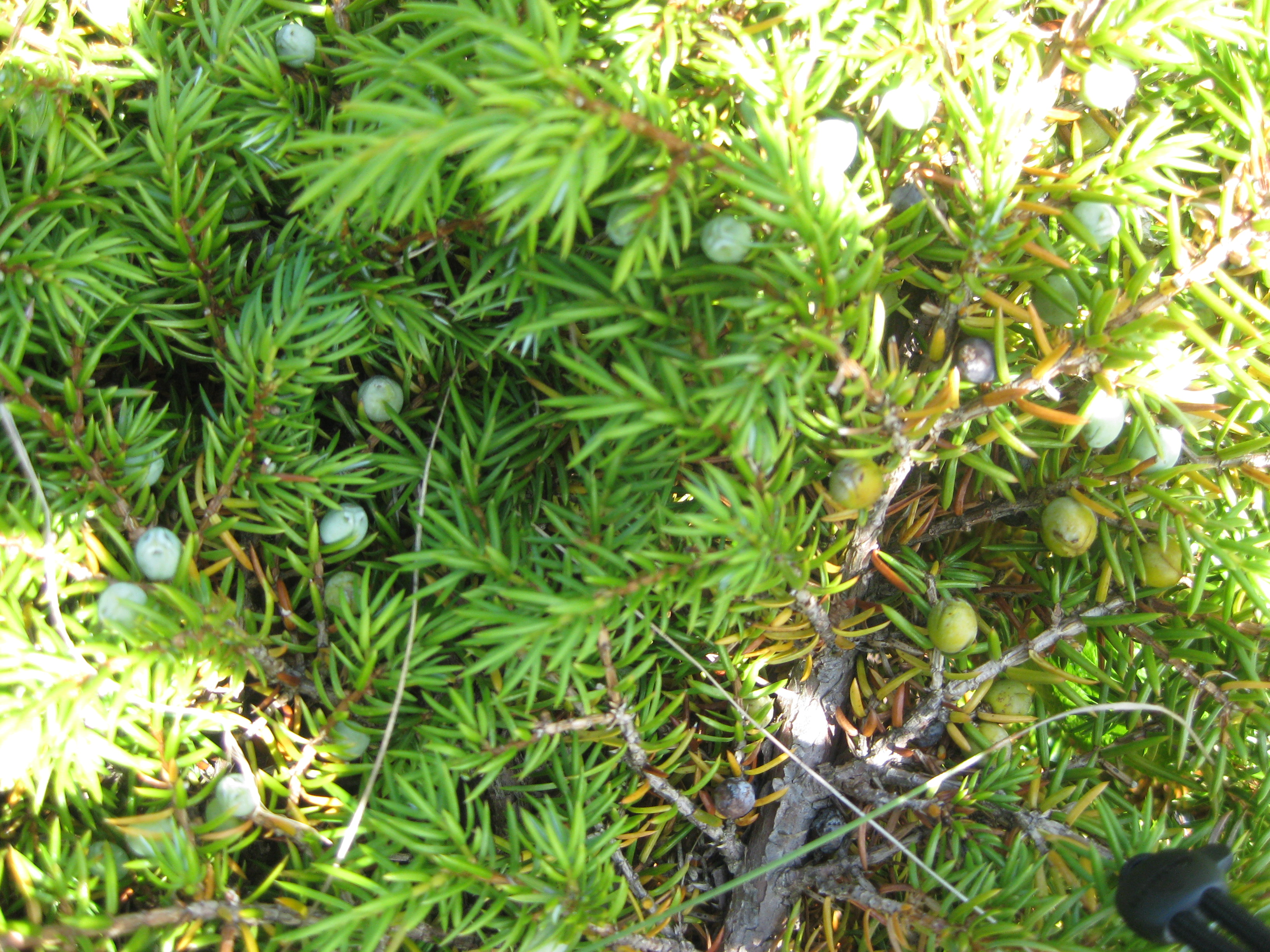
- Sarsaparilla.. I always loved root beer, and I once loved Porto (now too sweet for me), and this native berry tastes like a fruity combination of the two; when used in a sauce or coulis, or as a flavouring, it adds those delectable notes and depth. I bet that would be good with foie too.
- Wine caps (Strophaire à anneaux rugeux) - A noble mushroom variety new on the menu. Introduced to us by fellow mushroom fanatics, I was intrigued, and found them to be so dainty, nutty and delicate. Apparently they grows in wood chips, madly springing up the year after the ice storm, and are cultivated too - no worries, not dangerous. I have to find out more, and am not sure whether we could have enough to put on our mushroom menu anyway, but I’m pretty stoked about this newbie.
- I met the Canada lily for the first time (François says it’s rare in these parts) – what a remarkably beautiful flower – not edible though!

Some Quebec cheeses worth getting excited about..
- Tomme d’Elles de Charlevoix, Maurice Dufour
- le 1608, the now so popular Charlevoix washed rind cheese made from the heritage Canadienne breed of cow http://www.fromagescharlevoix.com/fromages/1608.htm
- l’Etoile Bleu de St-Rémi, my new favourite blue cheese, sheep’s milk
- Terre Promise, which I’ve talked about before, but it’s only gotten better (from the makers of Victor & Berthold, La Racam, Le Fétard) http://www.lanaudiere-guidetouristique.com/La-plaine-agricole/Fromagerie-Du-Champ-a-la-meule/
- Tomme de Grosse Ile http://www.fromagesdici.com/www/tomme_grosse.asp
Other ingredients:
- Highwood Crossing Canola oil : I fell in love with this oil at l’Eau à la Bouche years ago, but was reminded of it recently thanks to a newspaper article in the Globe.. Referred to as Canada’s EVO because it is cold-pressed, fresh and incredibly flavourful, this is a distant relative to the bland, processed canola oil that is so common. A finishing oil, to be used like the best extra-virgin olive oils, it has a fresh, buttery, nutty flavour, with sunflower seed and subtle sesame notes. I just ordered a 20L tub in the mail. Even with shipping charges, this is a good deal for the quality. http://www.highwoodcrossing.com/index.html
- Pettinicchi olive oils and vinegars: I have long been a fan of these products too, and it is forever exciting when our order arrives for the year, albeit with an ouch (but it’s worth it).. His chilli oil adorns just about every dish I make at home, and is one major reason I could never go completely local. http://www.pettinicchi.com
- Terre Sativa herb salt, and I’m only thinking about because I’m running out.. I don’t use this at the restaurant where I have every fresh herb on hand, but at home, it’s a staple. http://cld.portneuf.com/upload/cld.portneuf/editor/asset/Terra%20Sativa%20fiche%2006.pdf
My ‘coup de coeur’ starter dish of the summer uses all three of the above.. This is a salad that I ate every night at home this summer – little cucumbers and radish slices with Terre Sativa herb salt, black pepper, and chilli oil. Some times I added fresh cheese, or chopped egg or olives, and now I’m slowly moving tomatoes and corn into the mix, while the radishes fade out. Sometimes I change up the oil and vinegar (I have too many favourite oils and vinegars..). You have to love summer for how simple good food can be.
- La Ferme Quebec-Oies: Specialized in everything goose: foie gras, confits, terrines and etc.. I tasted their galantine d’oie (at the Marché du Vieux in Quebec City) and was won over. Clean goose flavour, sooo delicious! (lafermequebec-oies°videotron.ca, 418-826-0942)
In the kitchen
- I found a renewed interest and respect for agar.. (I love that it’s Ok to drop the second ‘agar’ now) Years ago, when agar was so very cool, mostly because it was a novel, vegetable source of gelatine that could withstand some heat, I went crazy with it. Only to ditch it eventually, concluding that it was a sub-par gelatine for my uses, and always grainy. It took a couple of years and a class in NYC to find new uses and rekindle some respect. I’ll always be more traditional and tend towards sheet gelatine or eggs for my preparations or any mousse, but I’m a little less biased today. Agar can make a nice liquid gel when you want a scoopable/shapeable sauce, or a vinaigrette with texture. And to set a braised mixture or terrine that you want to serve warm, it is pretty nifty.
- Bamboo steamer. This is a tool I don't call on much, but it came to the rescue when my homemade ravioli were bursting in a boiling water bath and I was in the juice. Sometimes, when you want intense but gentle heat, steaming is the way to go.
- My new favourite tool –a mini slotted spoon. Not holy like a Mac knife or microplane, but still, very useful in the kitchen, especially for plating. I also have a wide, flat topped spoon that is great too for controlled, neat portioning and saucing. Knives are mentioned all the time; the most neglected of important tools in the professional kitchen are spoons (for tasting and serving, slotted or wood, of all shapes, big and small)!
Dishes, some hits:
Customer favourites
- Cream of Lettuce soup with cucumber, fava bean and bee balm salsa – who would have thought? Usually any soup with mushrooms or wild greens, potato and bacon is a hit.. But with no meat and based on lettuce?? Quelle surprise.
- Scallops. Every scallop dish, whether seared, in ceviche or sashim, it appears you can't go wrong. Paired with wild ginger and sea greens, they especially make for swooning. . No wonder every other restaurant is serving them too, and fish mongers can’t keep up. Bad sign.
- A lobster bisque (Thai style) with sea spinach and cattail (I don’t think it was the wild things here that were winner, more like that heady mix of lime, coriander and coconut milk, and good bisque base of course).
- Strawberry and sweet-grass! Although sweetgrass is like vanilla or almond, good in just about every dessert, this particular pairing soars. I made a shortcake, a pavlova, sorbet and granite, used the mix in coulis, compote and jelly – all lip-smacks and smiles.
- Venison, braised or roasted: I take venison for granted because we have the farm on the property, and so I cook it all the time.. While I don’t want to put it in the starring role every week because I need to change things up, I see that people love it. I think the uninitiated expect venison to be gamey, and so are charmed by the subtle, savoury, better-than-beef quality of the meat. It doesn’t matter if I serve it with a crinkleroot mustard sauce, a wild grape balsamic, a wild mushroom sauce, it’s always a hit. And no matter how creative I like to get, I know I could make a fancy Shepard’s pie every week and customers would be happy. If said rustic dish wasn’t getting as tired as crème brulée in the food world, I might make it more.

My favourites
- Consommé, wild ginger or mushroom. I realize this is more of a winter dish and maybe I’m ‘in’ because I hadn’t made it in months. But it always excites me more than the customers anyway, who seem just as happy with a typical soupnancy purée type soup, which is so much less work. Why do I bother? Because I like a good broth. Because consommé is cheffy (something you don’t do at home). Because it’s pretty. What I especially like about consommé is the layers of flavour - the idea of boosting my duck broth with extra umph through what I put into the clarification raft like mushrooms or ginger, flavours that you can’t see, but come through strong and clean and clear, pure elegance.
-
Crinkleroot French toast (this was a true personal fave); I used it to sop up escabeche but I see it with fresh tomatoes or tomato confit; now, I’m just waiting for the tomatoes…
- Ham and cornbread salad. I love ham and put a lot of love into making it. Customers appreciate it in any given dish, but rarely understand how much work is involved, what special ham it is. Like with the cornbread salad, which is something I have been making since I was a catering young one, I could be using couscous and few would notice. People say yum, but I know the cornbread was for me, more than for them. I tell myself it probably would be less 'yum' if the ham and couscous were store bought.
Eating oysters throughout summer.
I think this is the first summer that I eat oysters on a regular basis, no matter how oyster-loving we are. Like for most people our age, oysters have traditionally been a fall and winter thing. Even though there has been a good supply for years now in the R-less monthes, and it is better than ever now with the rise in popularity of oyster bars and such. I’m thrilled because they go awfully well with hot weather and sparkling wine, especially our east coast Virginicas. Regardless of how often I try the ‘others’ like the Pacifics or various exotic varieties, I can’t get into that flabby taste; I need the salt, and cold water tang of Malpeques like Coleville Bay, Raspberry Point, Glacier Bay and co..
BTW, An informative and entertaining book on oysters for amateurs and fans, or anyone curious about oysters: Geography of Oysters by Rowan Jacobsen. www.rowanjacobsen.com
Restaurants
- I hardly dined out much this summer, but there was Bistro-Bar Chez Roger, one of François’ favourite spots (by the same chef team as Kitchen Galerie) that I recently got to know: Solid haute bistro market-fare (oysters, terrines, tartares, short-ribs, fish and chips and much more) with good wines, and a great vibe. http://www.barroger.com/
- Tartare table-side! Like in the good old days. And this one was GREAT! At L’Auberge Le Baluchon in St-Paulin, LaMauricie: where the true country setting is beautiful, spa and such comforts included, and there is a refreshing social conscience attached (as far as promoting local producers and Quebec in general, recycling, respecting nature, fair-trade - even healthy and allergenic diets are considered here, poor cooks). The service is earnest and abundant (more than fine tuned); there is a lot to like about this place. Although the food was mostly mediocre for the price, I had that super (REALLY!), nostalgic tartare at night, and in the morning, the best ham sandwich I’ve had in ages at their Eco-café on Berbere bread. Even with just a few things right, because they were SO RIGHT, this Quebec tourist attraction left me with a major sweet spot.
A piece of writing that I thought was fabulous, The Case for Working With Your Hands, by Matthew B. Crawford, A New York Times Article.
http://www.nytimes.com/2009/05/24/magazine/24labor-t.html
Books:
- Apples to Oysters, A Food Lover’s Tour of Canadian Farms, by Margaret Webb There isn’t much true Canadian food writing out there, outside the cookbook, travel and special interest genre.. Here is a uniquely personal account of a cross-country eating tour that celebrates the best of Canada with a focus on a few great artisans more Canadians should know about, who are producing real, good food. http://www.margaretwebb.com/
- Eating at Church, A book of Recipes from Aylmer & Eardley United – Ok, this is hardly a coffee table cookbook and probably of interest to few in the new jet-set world of foodies. But I liked this modest little book mainly for the historical/sociological aspect, because it is typical of thousands across the country in decades past, when the church was so all important in most Canadian lives. I include it here mainly as a reminder of another kind of cookbook, one that isn’t big and glossy or promoting a chef, restaurant or new diet.. For me, it also offered up a slice of nostalgia because I feel like I gobbled up my fair share of this food as a child, not only at buffets in the church hall, but at my parents’ friends homes – hot cross buns, deviled eggs and bean casseroles, recipes that use soup mix and cream cheese, ham spread and jello, cranberry punch and trifle of all kinds - all infused with loads of personality and a sense of community.
- François Chartier’s Papilles et Molecules I find this stuff fascinating, even if I don’t think it’s so important. Breaking down the flavours in food and wine to chemical components and matching them doesn’t seem to turn up so much more than what we already know from experience or instinct. Granted, there are a few surprises that surface from the mix. In any case, it is gleefully refreshing, even comforting to have science confirm things you already know. And it is inspiring to be led down a different path, say when it comes to rosemary and Alsatian wines.. New ideas open up, only because of his different approach. This is hardly a complete work, but it is ambitious all the same; he has surely done a lot to kick off a whole other branch of wine and food pairing… Even if I know this is not a book I will pick up again and again, I value it now for the novelty, for the odd brainwave it inspired, for all his research. www.francoischartier.com
No - No Julie and Julia! Haven't seen it yet.
